| |||||||
| Search Forums |
| Advanced Search |
| Go to Page... |
 |
| Search this Thread |  504,111 views |
| | #1 |
| Senior - BHPian | Honda Civic : Official Review The Honda Civic is on sale in India at a price of between Rs. 17.94 - 22.35 lakhs (ex-Delhi). What you'll like: • Funky & futuristic styling • Top-notch build and quality of construction • Smooth, rev-happy petrol or a practical diesel – take your pick • Fun handling…with a very sporty driving position to match • Cabin has a nice design, good space & spot-on ergonomics • 5-star safety rating & kit (6 airbags, ESP, HSA etc.) • Well-equipped. Lane watch camera, remote engine start, dual-zone air-con & more What you won't: • Weirdly, no Petrol MT or Diesel AT offered • Neither engine is fast & performance levels are ordinary. Enthusiasts, look elsewhere • Many will find the seating to be way too low. Ingress & egress aren’t convenient either • Useable boot, but it’s the smallest in the segment (even City has a bigger boot) • GTO & I experienced lower back pain after a long drive in the MT. Lumbar support missing • Hard to justify the ~50% price premium over the City. It’s also more expensive than the Elantra & Corolla Last edited by GTO : 18th July 2019 at 12:34. |
| |  (62)
Thanks (62)
Thanks
 |
| The following 62 BHPians Thank blackwasp for this useful post: | 2himanshu, A.M., akshay81, Anumon8448, AutoIndian, AYP, blackasta, Carzman, CEF_Beasts, chiefpk, chinmaypillay, CrAzY dRiVeR, Cyborg, Dani7766, Dr.AD, DrANTO, d_himan, ganeshb, Gannu_1, gauravanekar, GTB, GTO, haisaikat, hmansari, InControl, jailbird_fynix, Keynote, Klub Class, lemedico, Lobogris, MotorDev, Moto_Hill, N33raj, nakul0888, naveen.raju, NaXal, Obi-Wan, phoenixash, planet_rocker, PrasunBannerjee, RavenAvi, Redline6800, Reinhard, RJ2285, SaiSW, Scorpion 10, SDO, shancz, shobhit.shri, Simat, Simhi, SnS_12, Sunny_team_bhp, tazmaan, theexperthand, THE_DRIFTER, The_Outsider!, tjacob, uday.ere, vredesbyrd, VTec_KickedInYo, vvrchandra |
| |
| | #2 |
| Senior - BHPian | Review Index: Exterior Last edited by Aditya : 16th July 2019 at 14:56. |
| |  (18)
Thanks (18)
Thanks
 |
| The following 18 BHPians Thank blackwasp for this useful post: | AutoIndian, blackasta, CrAzY dRiVeR, Dr.AD, Gannu_1, GTB, GTO, Klub Class, MotorDev, neil.jericho, phoenixash, RavenAvi, Redline6800, Simat, SnS_12, theexperthand, uday.ere, wheelspinner |
| | #3 |
| Senior - BHPian | Exterior 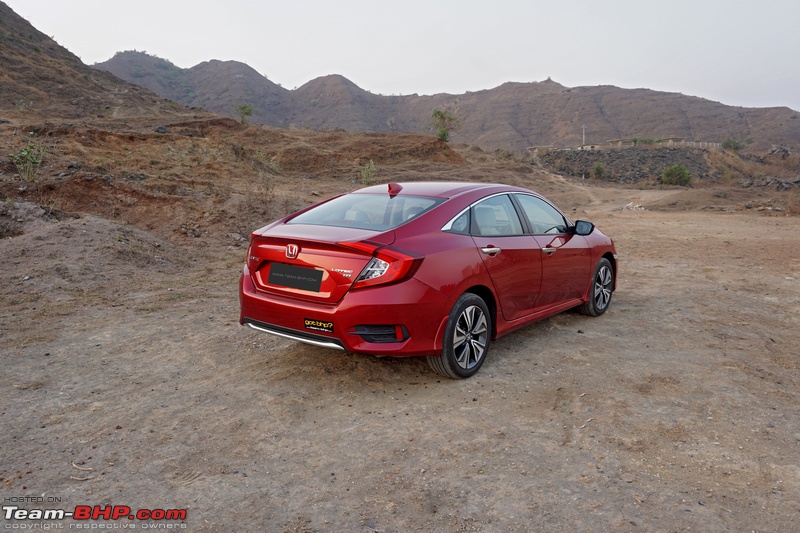 The Civic nameplate is almost 50 years old, with the 1st-generation going on sale globally in 1973! The Civic brand has a lot of familiarity, especially among Indians who've been seeing private imports since the 1980s. Honda sold the 8th-gen Civic in India from 2006 till 2013. It was a car that stood out from the others in the market, thanks to its futuristic design (looks good even today). The 9th gen-model however never made it to India. Reason = Poor D1 segment sales (related thread). Besides, Honda had become busy with the sub-10 lakh segment in which it had almost no presence earlier. The 10th-gen Civic is late in coming to India (launched internationally in end 2015). It is based on an all-new global platform. In India, cars sharing this platform include the Accord and CR-V. The platform is also compatible with a two-motor hybrid system. The Civic has a quirky front, which is dominated by a large chrome applique on the grille. This is due to mass market tastes which love bling. On the sides sit two full LED headlamps with L-shaped DRLs, while circular LED foglamps are housed below in the bumper. A slim air dam is located between the foglamps and the bonnet gets prominent humps on the outer sides (visible from inside). The talking point of the car is its sleek coupe-like roofline. At the rear, the design is a bit more edgy than the front, and opinions about its design might be divided. Fit and finish are good and there are no inconsistencies anywhere. The car weighs between 1,268 and 1,353 kg depending upon the variant. The build quality is good as well, with the thickness of the body panels being substantial all over the car. The doors & bonnet have some weight to them and feel reasonably solid. The paint quality is superb and the car is available in 5 colours. 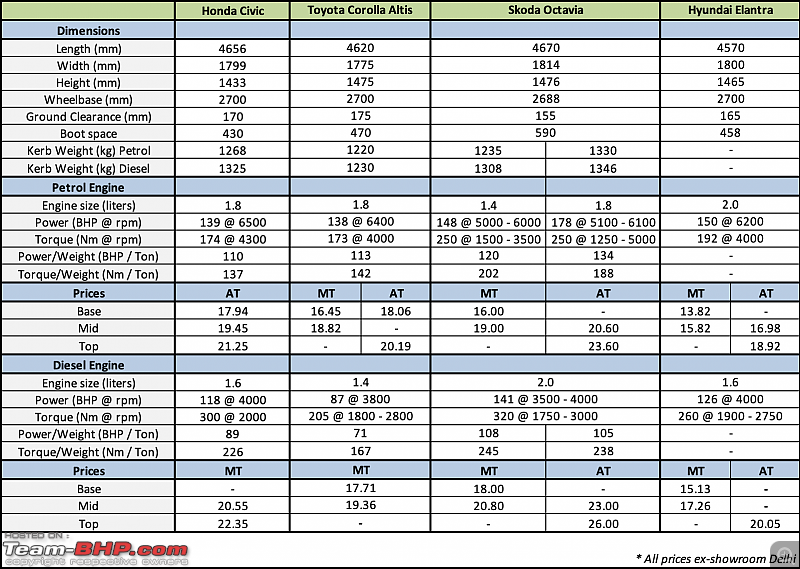 The new Civic measures 4,656 mm in length, 1,799 mm in width and 1,433 mm in height. Compared to the 8th-gen car, it's 111 mm longer and 49 mm wider, but 17 mm lower. Its wheelbase of 2,700 mm is identical to the old car's. For India, the Civic gets a ground clearance rating of 170 mm, which is identical to the 8th-gen car. However, I'm happy to report that the new Civic doesn't scrape its belly on speed breakers - something that the old car was notorious for. Compared to international markets, for India, Honda claims to have increased the front and rear ground clearance by 20 and 15 mm respectively. The car's boot space is rated at 430 liters, which is the smallest among D1 segment sedans. If we have a bone to pick, it would be with the engine-gearbox combinations on offer. The diesel is offered only with a manual gearbox, while the petrol comes only with a CVT! At present, diesel automatics are the preferred choice in the D1 segment, while a petrol manual would have been preferred by enthusiasts. The old Civic was a popular car in the modifications scene. We don’t think we’ll see too many of these modifications in the new Civic because of the ordinary engine + gearbox combinations. Enthusiasts, look elsewhere. Performance levels are more "C2" segment than "D1". In the area of safety, the Civic gets dual front airbags, side front airbags, seatbelt pre-tensioners, ABS with EBD, ISOFIX child seat anchors, hill start assist, electronic parking brake with brake hold, vehicle stability assist, agile handling assist and rear parking sensors as standard. A reverse camera is offered in the VX and ZX variants, while curtain airbags and a lane watch camera are available in the ZX (top variant). The car has scored a 5-star rating in the ASEAN NCAP crash tests. Honda is offering a 3 years / unlimited km standard warranty that can be extended to 5 years / unlimited km. We strongly recommend taking the extended warranty as modern cars get complex electricals. Coming to the subject of pricing, among its peers, only the Skoda Octavia is priced higher (specifically the top-end diesel AT variant). The Hyundai Elantra as well as the Toyota Corolla Altis undercut the Civic. The front gets a chrome applique flanked by full LED headlamps on either end. Notice how the slim chrome bits extend over the top of the headlamps. Lots of chrome on the front because of mass market tastes. Overall, the Civic looks much more modern than before: 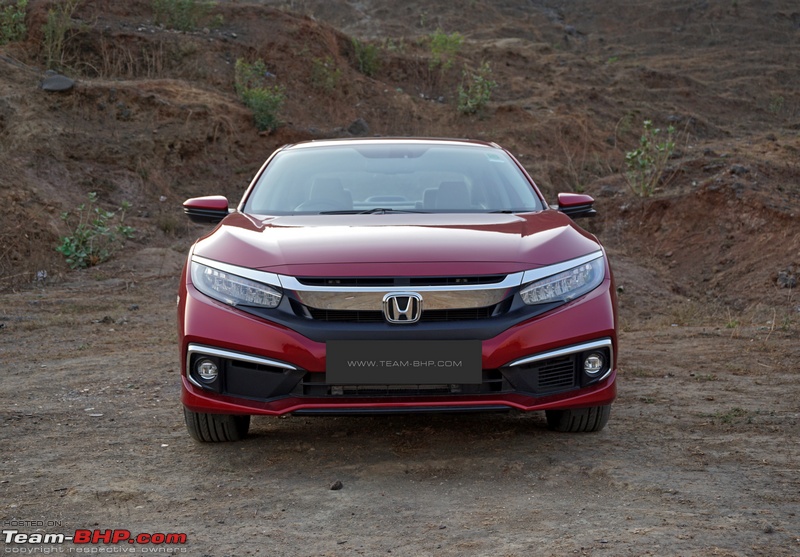 C-shaped tail lamps are a size too big. They extend onto the boot lid and merge into the small lip spoiler. The bumper gets a chrome strip set in a black insert. Now we know where the Amaze got its inspiration. The resemblance is easy to spot: 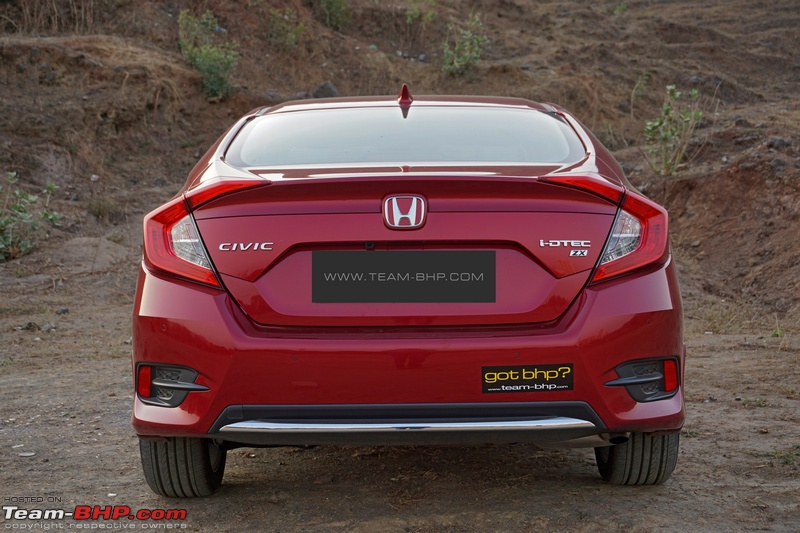 Coupe-like shape with the roofline merging with the boot lid - the talking point of the Civic's design. Prominent shoulder line flows along the side. Front and rear overhangs are short and the design looks well proportioned overall. Our test car looks fantastic in this Radiant Red colour: 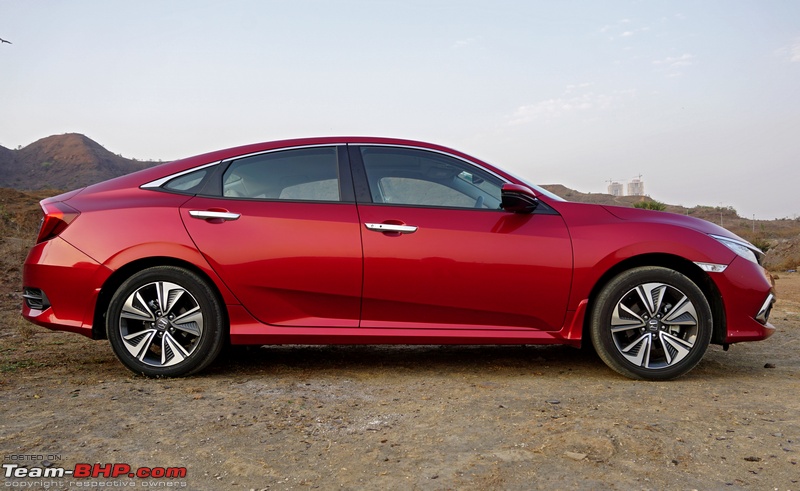 The Civic measures 4,656 mm in length, 1,799 mm in width and 1,433 mm in height with a wheelbase of 2,700 mm. Honda has used strong character lines, which is a total contrast compared to the 8th-gen car: 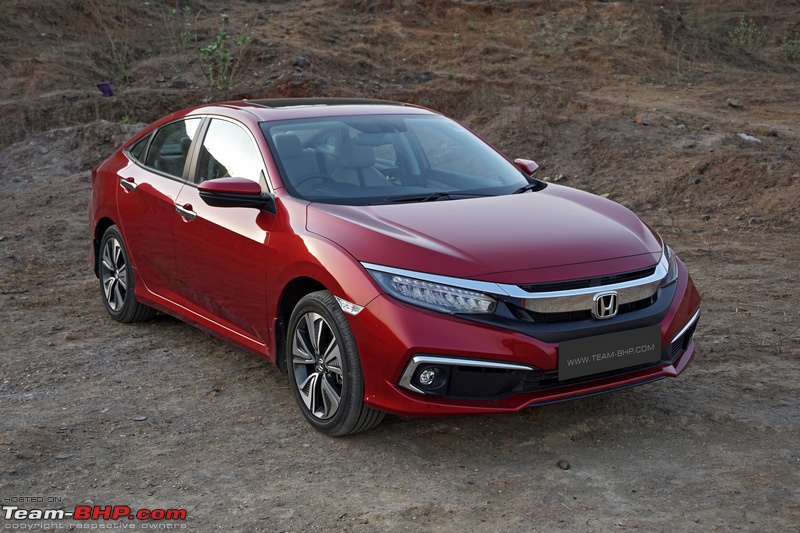 While the front three-quarter view is good looking, opinions will be divided over the rear. While some feel it is edgy, others think it stands out and suits the car. Personally though, I am a fan of this design. It looks especially good at night with the tail-lights turned on: 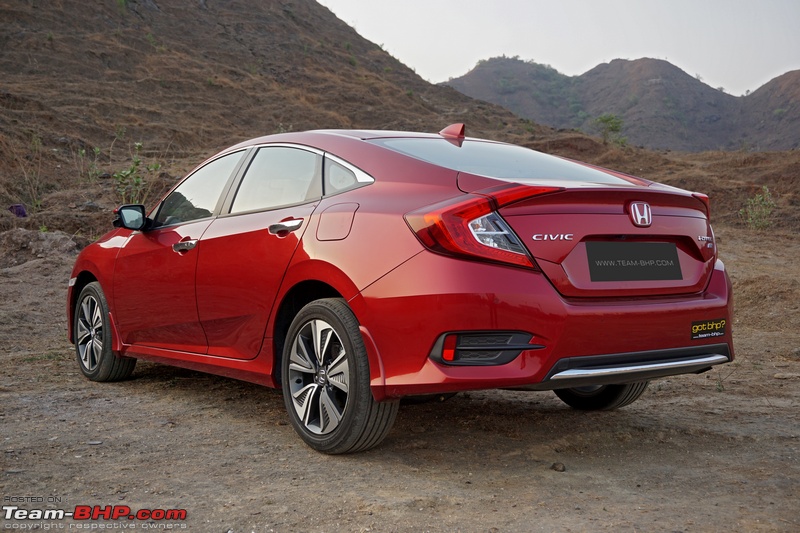 Only the top-end ZX gets full LED headlights. Honda should have offered these as standard. The top gets a chrome eyebrow that merges into the larger chrome piece at the center: 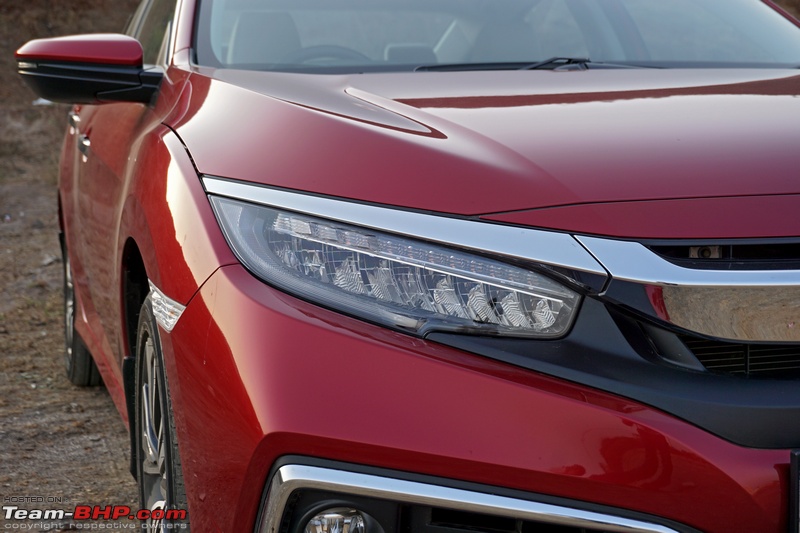 With all the lights in action. The top portion is the indicator light while the outer L-shaped one is the DRL: 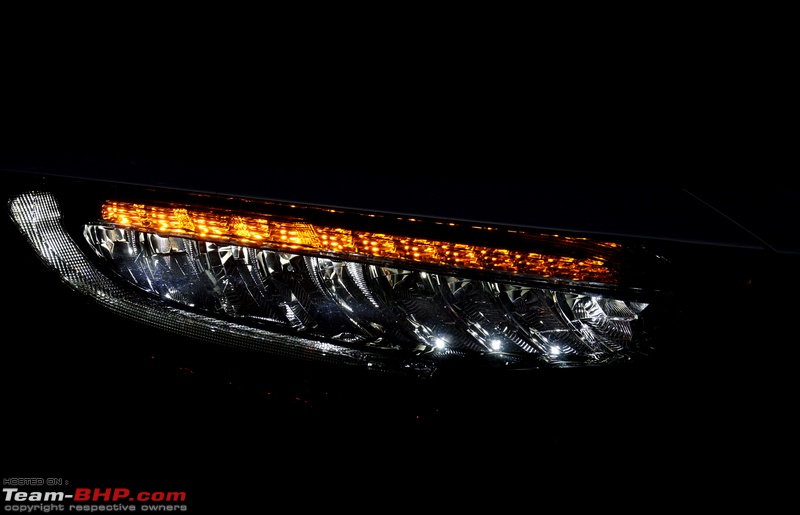 With the DRLs on. These are bright and make the car noticeable even during the day: 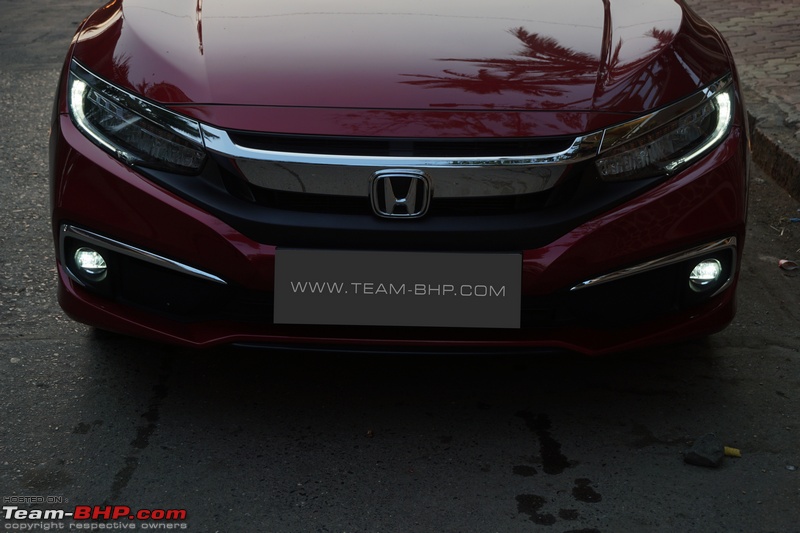 Thick chrome insert dominates the front, but somehow, does not look overdone. There are slim vents above and below the chrome piece. Notice how the black plastic and the chrome merge into the headlights. Sweet touch: 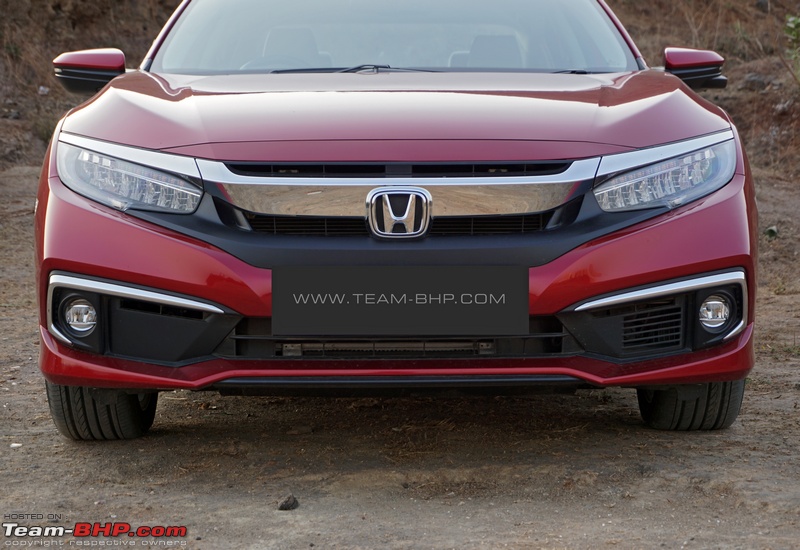 Twin-slat air dam is slim and gets LED fog lamps on either side. While each foglamp gets a small slat beside it, the one on the left has an additional air vent with horizontal slats next to it: 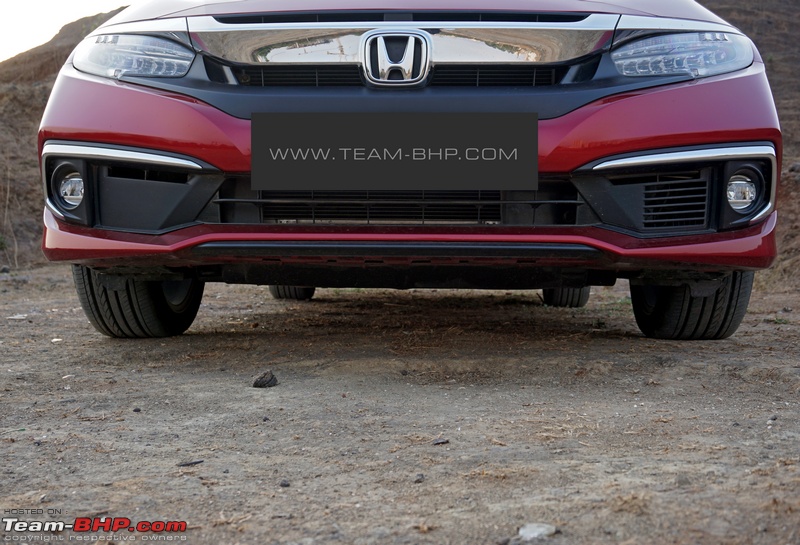 Dual disc horn is placed behind the vent next to the left foglamp. Inverted L-shaped chrome inserts around the foglamp housing looks classy: 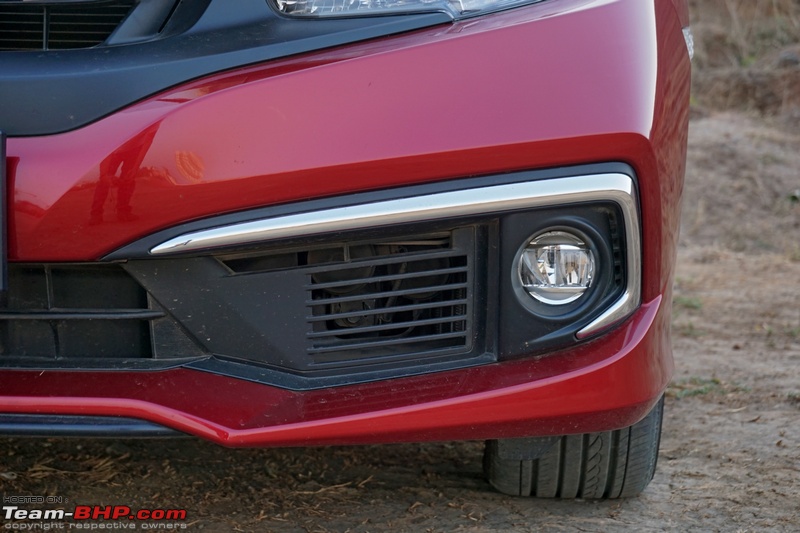 Both the petrol and diesel get solid underbody protection plates: 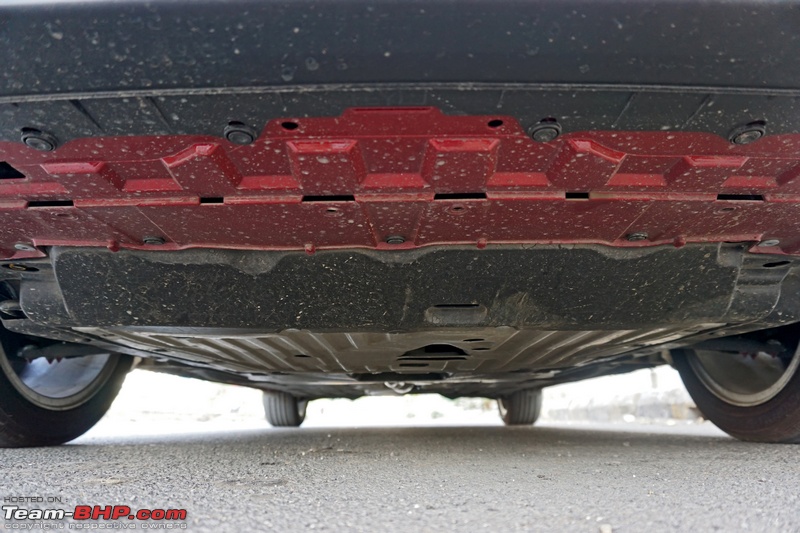 Clamshell bonnet gets prominent crease lines in the center. The bonnet is raised at the sides. Tall folks can notice this from inside the car. Looks very cool. Only the diesel gets a pop-up hood for pedestrian safety: 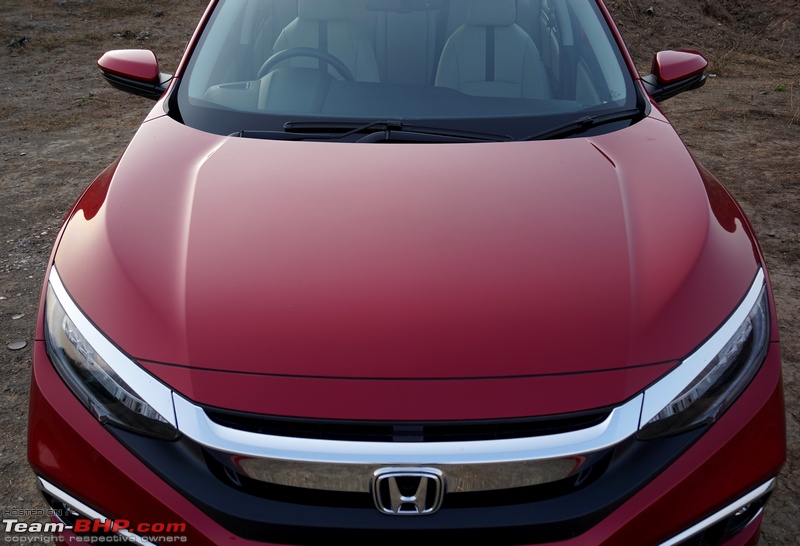 Windshield wipers are partially concealed under the bonnet: 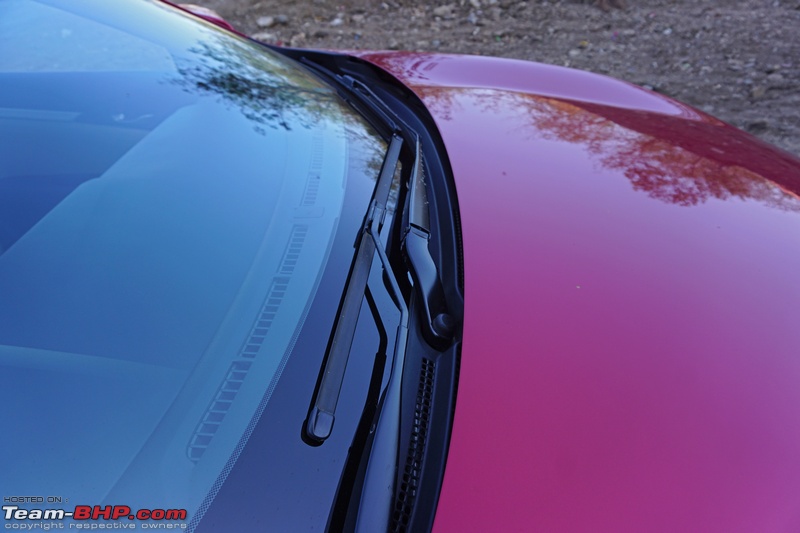 Washers are concealed under the bonnet as well. They squirt out effective sprays (rather than jets) of water: 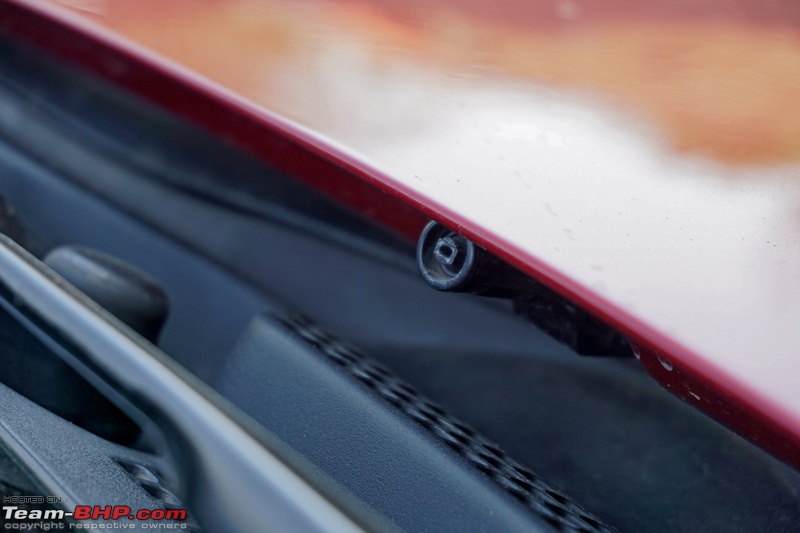 Big wipers cover a good portion of the windscreen and operate silently: 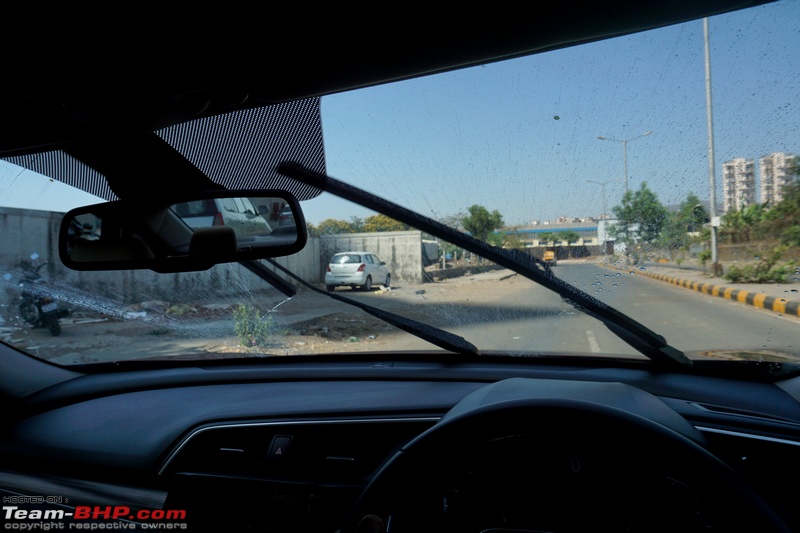 Shut lines are consistent and tight. Honda has managed a top class effort here: 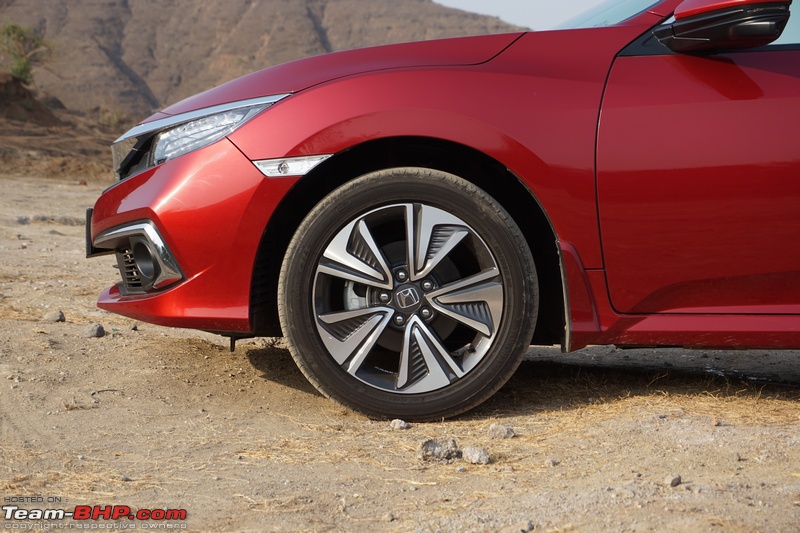 Shut lines are slightly wider around the boot lid, but they are consistent:  Electrically foldable ORVMs have integrated turn-indicators: 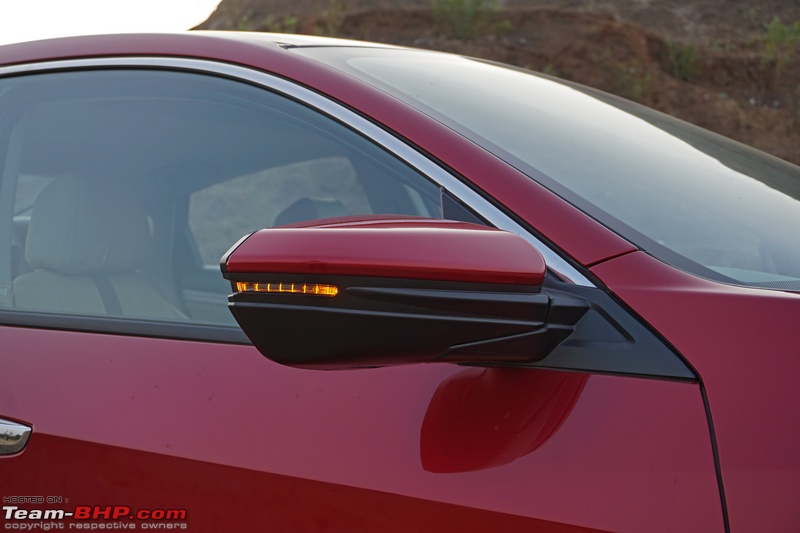 Left ORVM gets a camera for the Lane Watch system. Be aware that this would definitely be expensive to replace if the mirror is swiped by a biker: 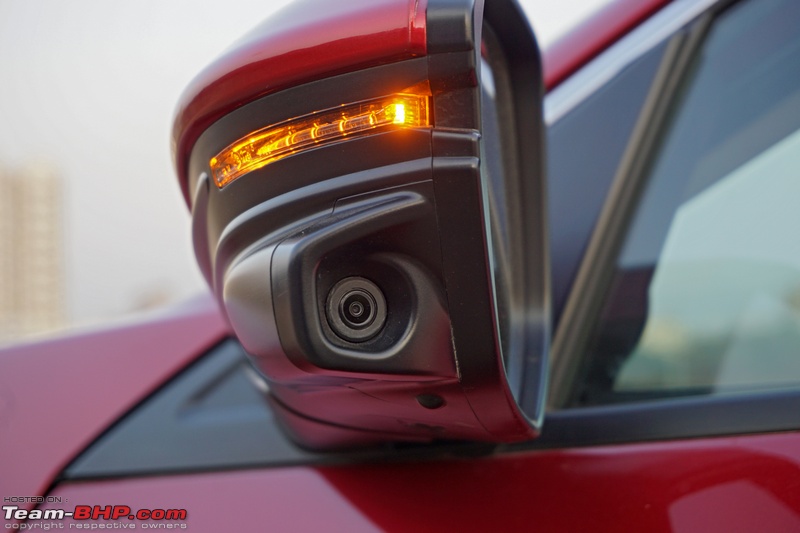 Door handles are draped in chrome. They feel robust and well fitted. Both the front units get black request sensors: 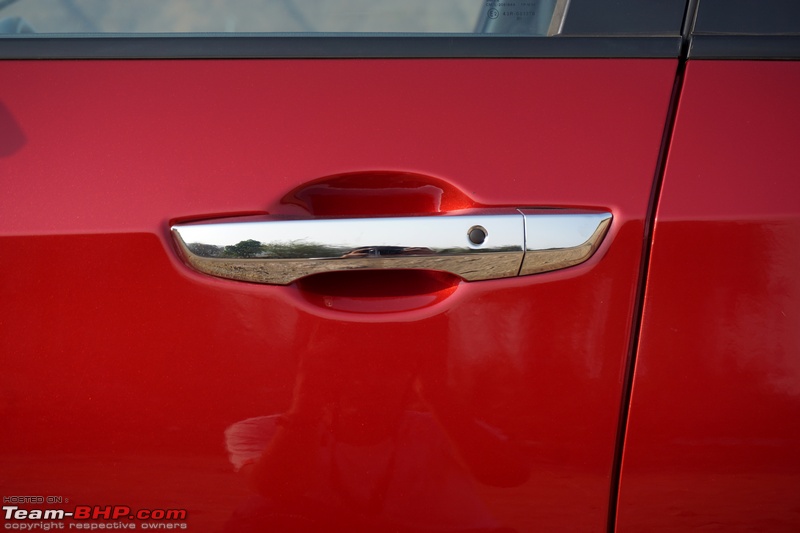 To unlock the car, just insert your hand behind the door handle with the keyfob on your person: 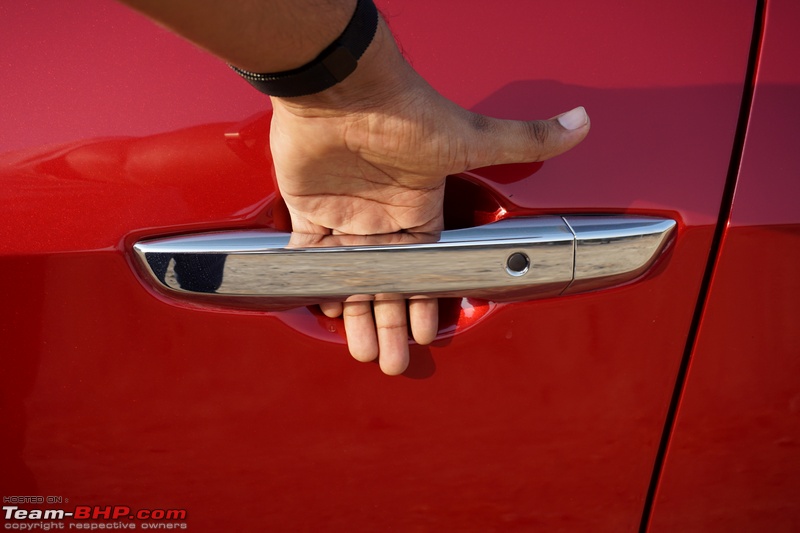 5-spoke, 17-inch alloy wheels are shod with 215/50 section Yokohama Advan dB tyres. The rim design is funky. Some will love it, some will hate it. Lower variants get 16-inch rims shod with 215/55 section tyres: 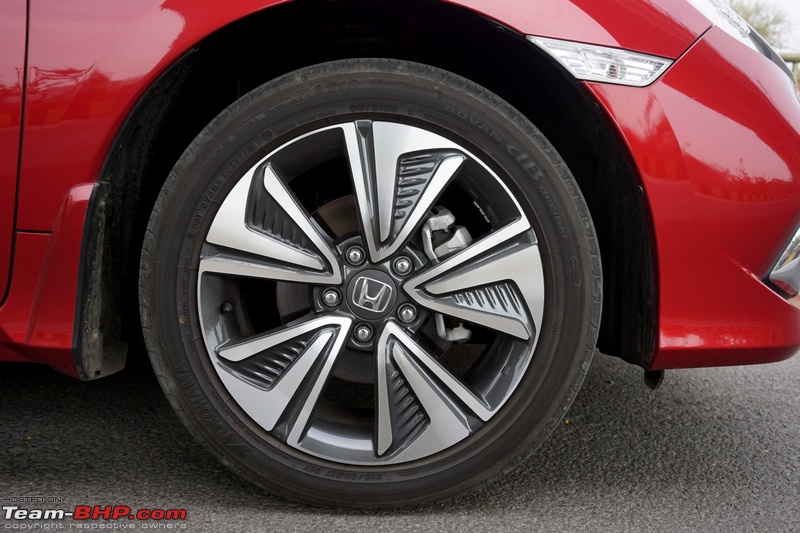 All variants are equipped with disc brakes all-round: 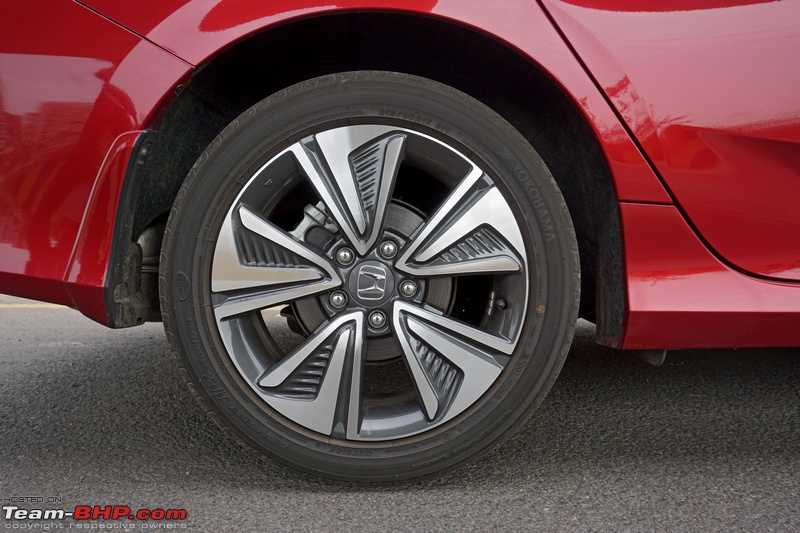 Glass area is large and lets in a decent amount of light. Quarter glasses at the rear help further. See how the C-pillar slopes downward sharply eating into the headroom at the back. A chrome strip runs only along the top edge of the window line: 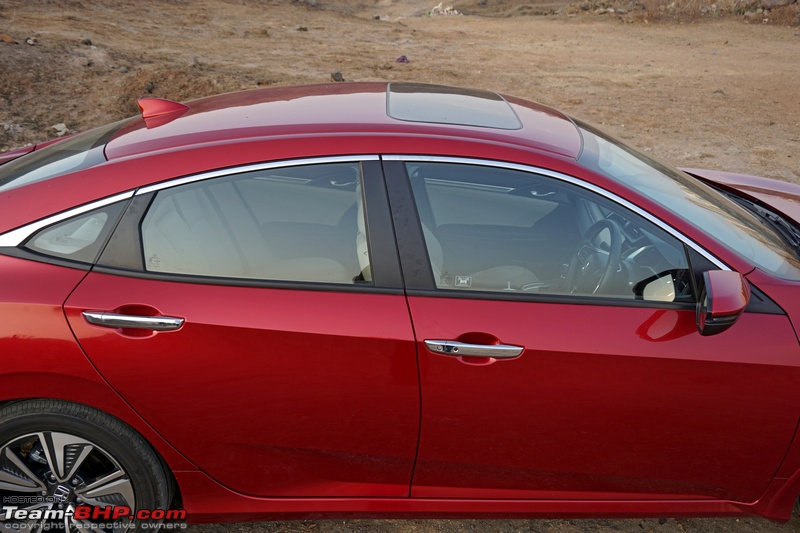 Front wheel arch is prominent. Curved bonnet line runs parallel to it: 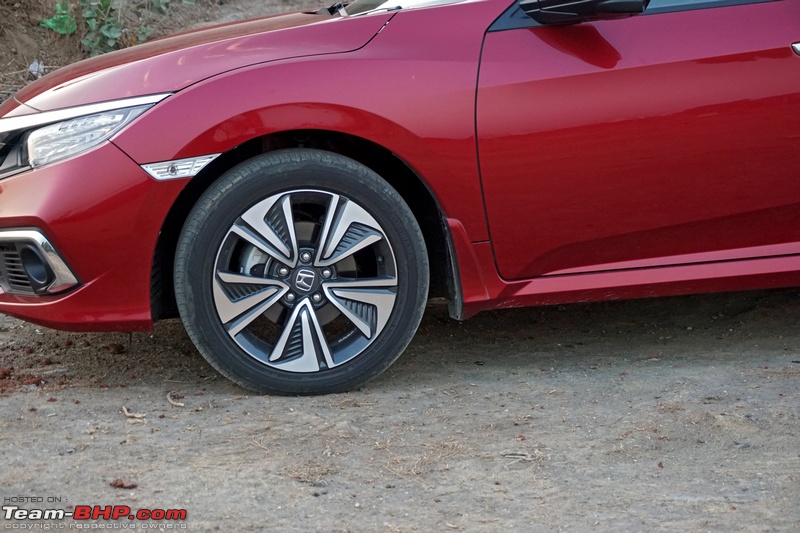 The shoulder crease starts on the front panel, runs along the doors... 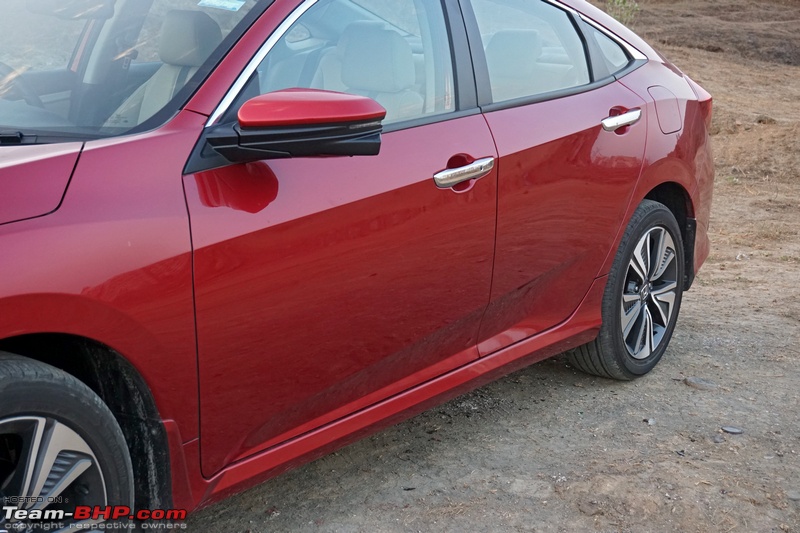 ...and curves over the rear wheels before merging into the tail-lamp. The rear wheel arch is not as prominent as the front: 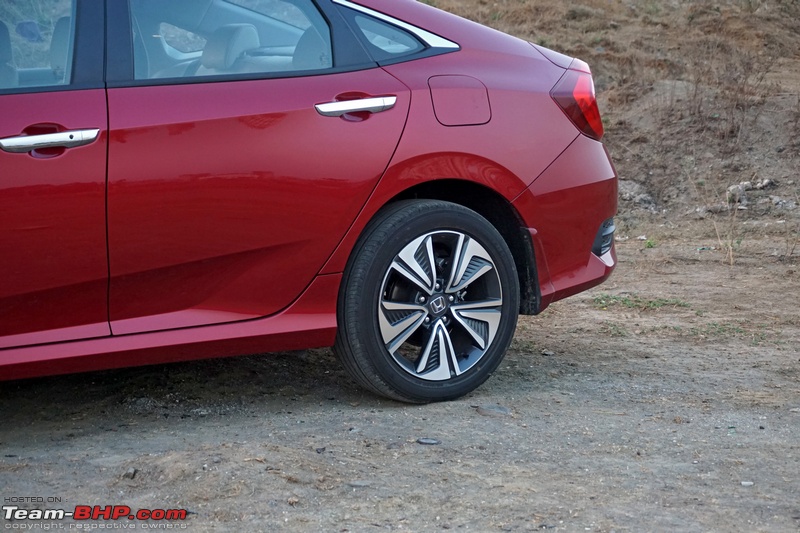 The lower part of the doors gets a strong crease that climbs upward at the rear: 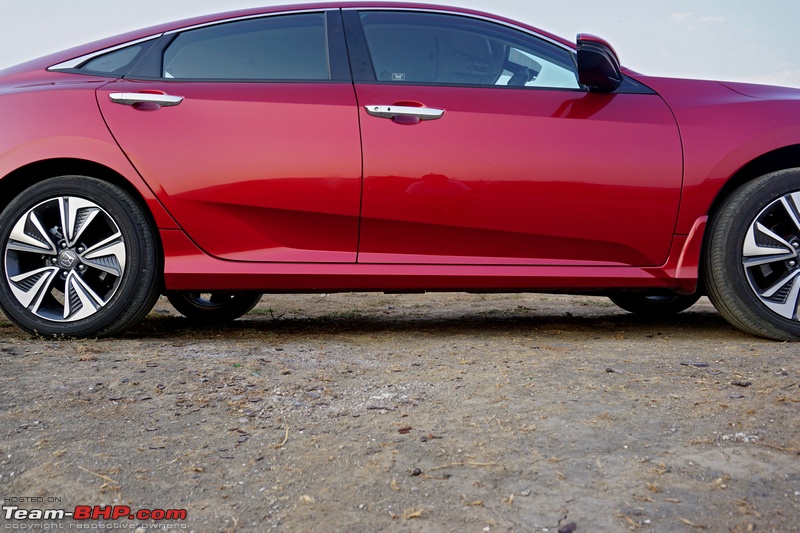 ZX variant gets a very-welcome sunroof: 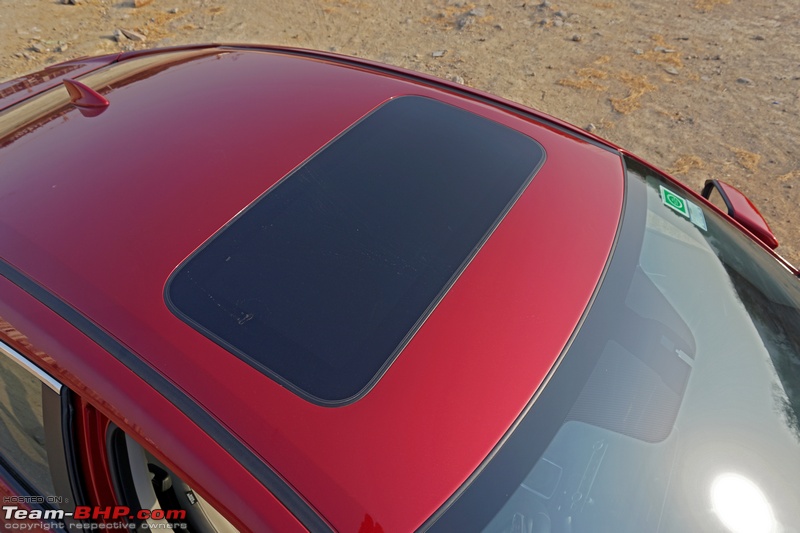 Sharkfin antenna sits at the very end of the roof section: 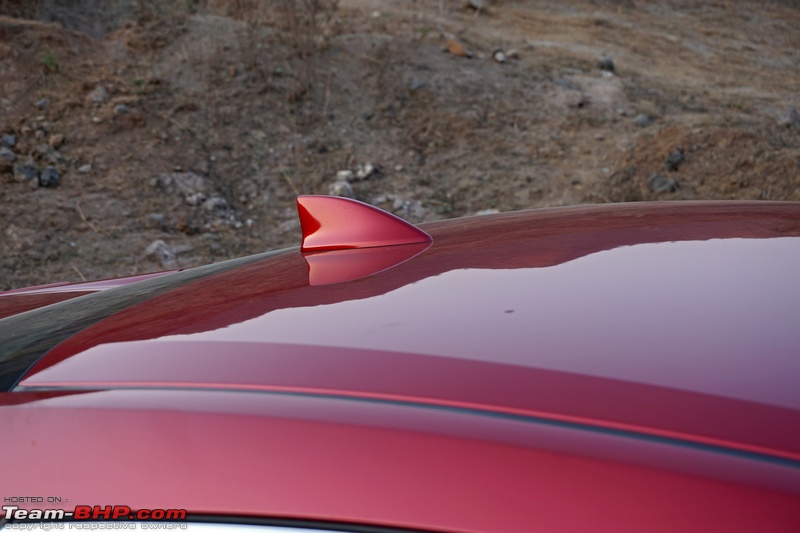 Fastback-styled rear end gives the Civic a coupe-like appearance: 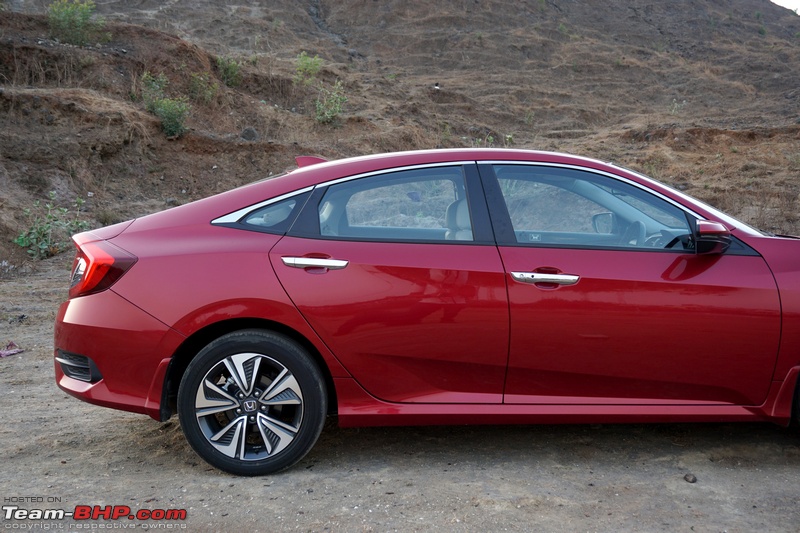 Interestingly, the rear windscreen does not sit flush with the C-pillar: 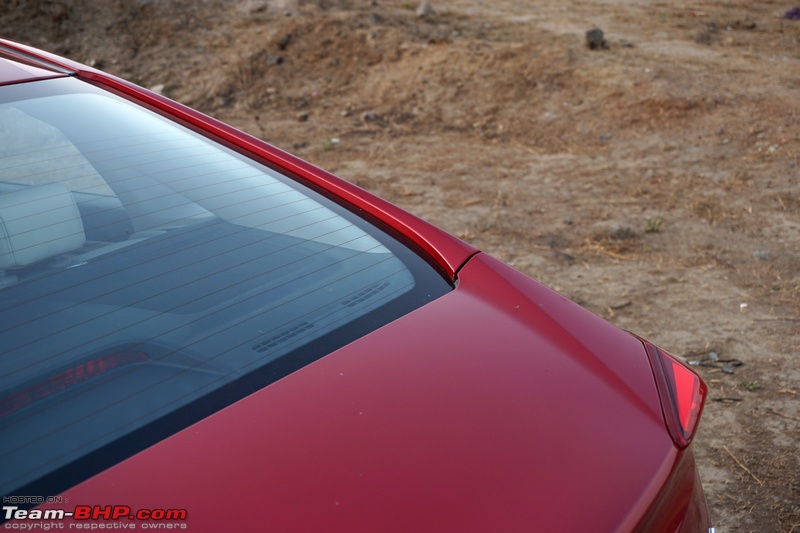 The boot lid gets a small lip spoiler: 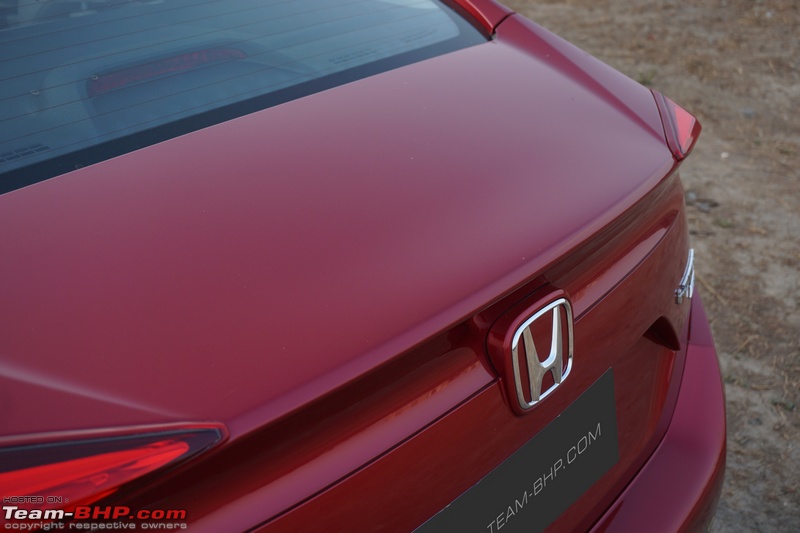 Split C-shaped LED tail-lights with clear lens turn-indicators and reverse lights. Even the part on the boot lid is functional. These funky tail lamps look better on light coloured cars than our demo’s red: 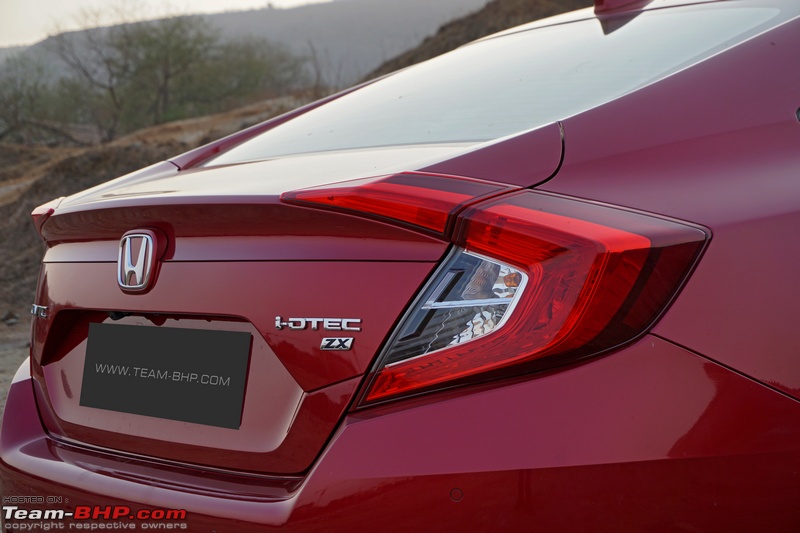 With all the lights in action. These look brilliant from a distance: 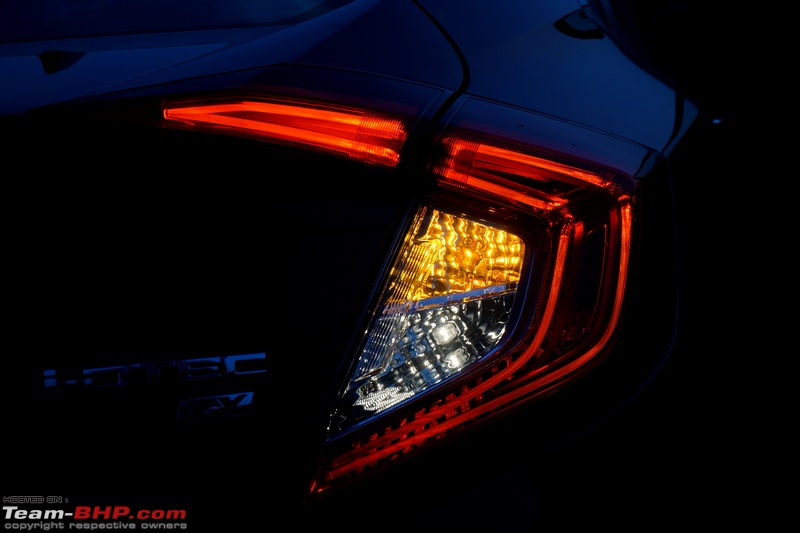 Model badge on the left and the engine + variant badge on the right. Notice how the tail-lamps merge with the boot lid: 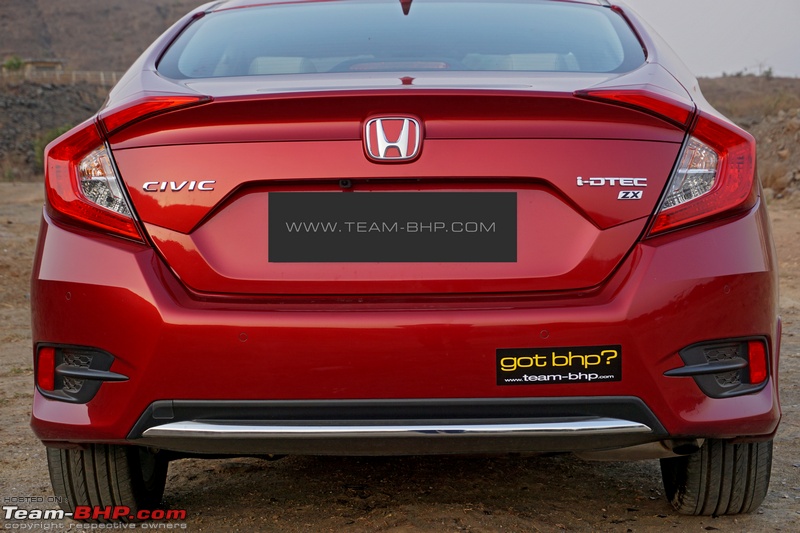 The 2 parking sensors in the middle are placed lower on the bumper than the outer ones, which are located on curved parts in order to provide maximum coverage. Small, vertically oriented reflectors are housed in black inserts on the corners of the bumper: 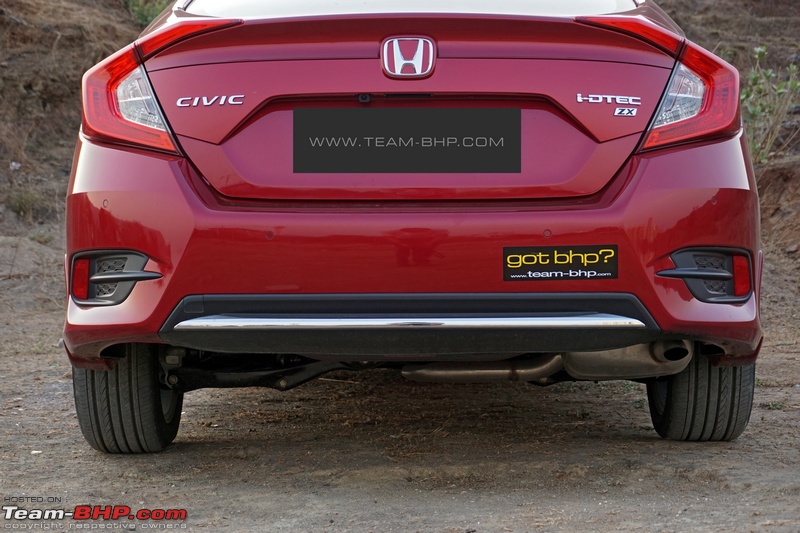 Reversing camera is placed beside the number plate illuminator towards the left: 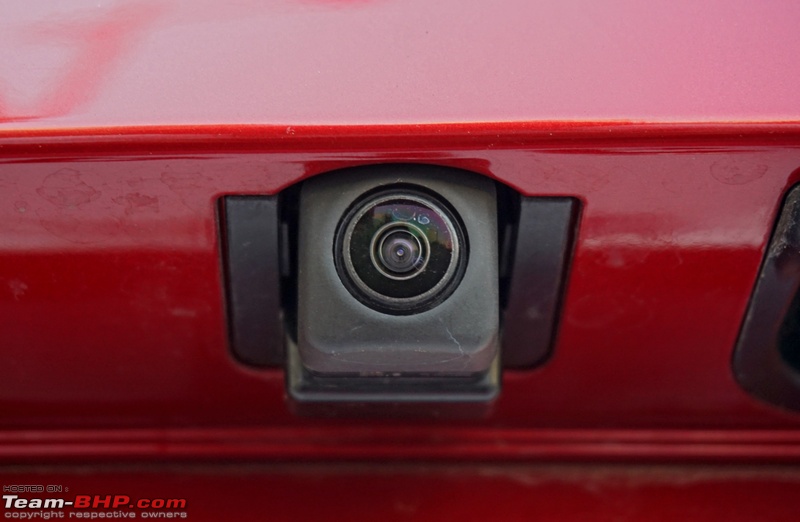 Lone LED number plate illuminator with electromagnetic boot release behind it: 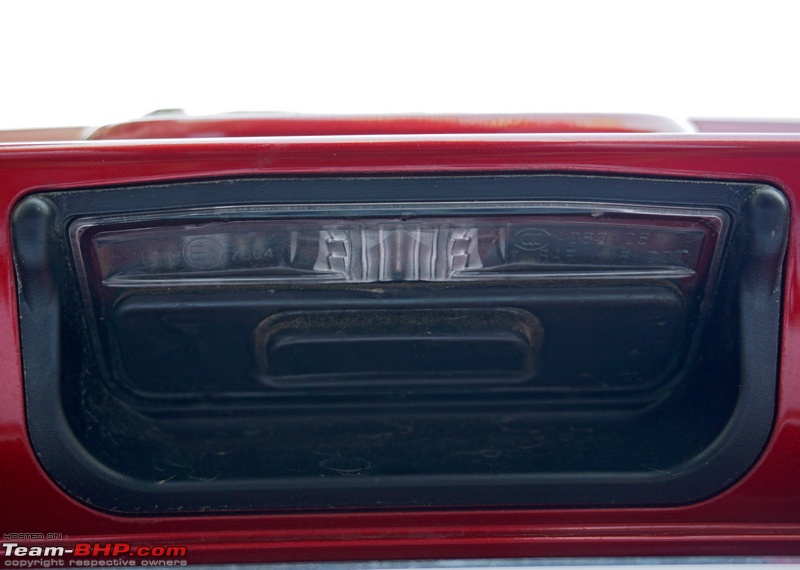 No badge denoting the automatic transmission! We think Honda has missed an opportunity with the engine and gearbox options with no diesel automatic or petrol manual on offer: 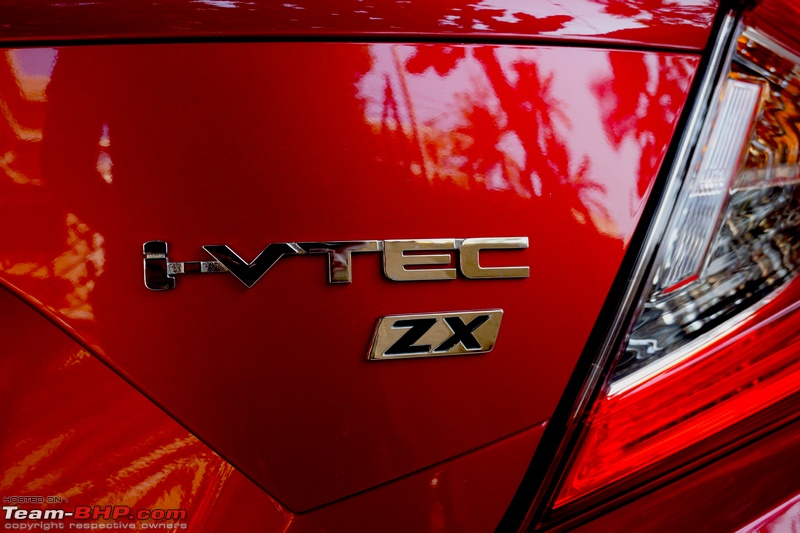 Single exhaust snakes its way under the car before reaching the silencer on the right: 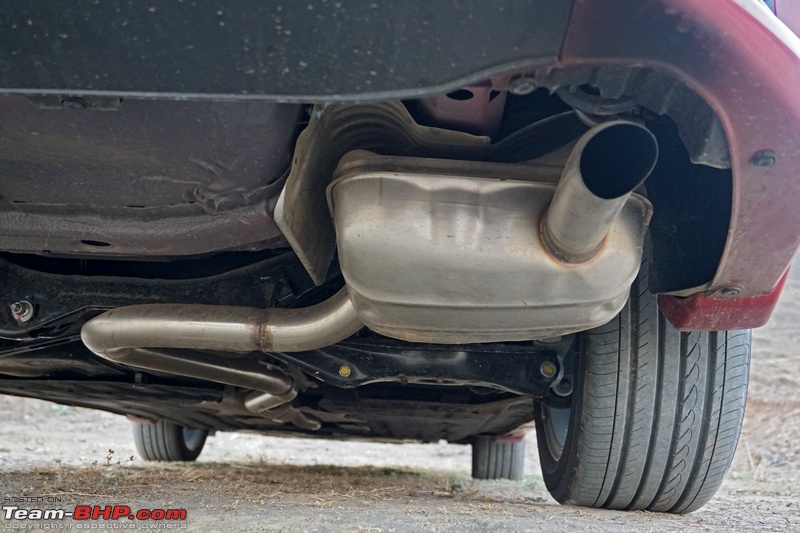 Multilink suspension with coil springs at the rear: 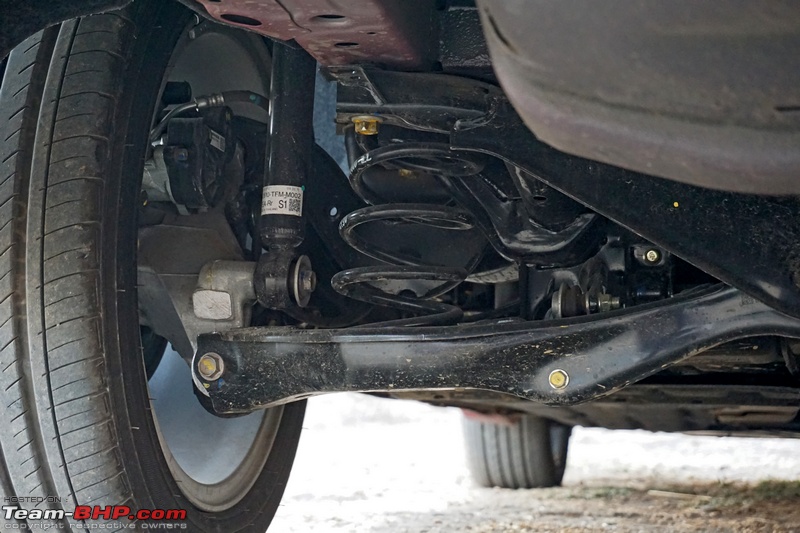 With the 8th-gen Civic. The new car definitely looks more modern: 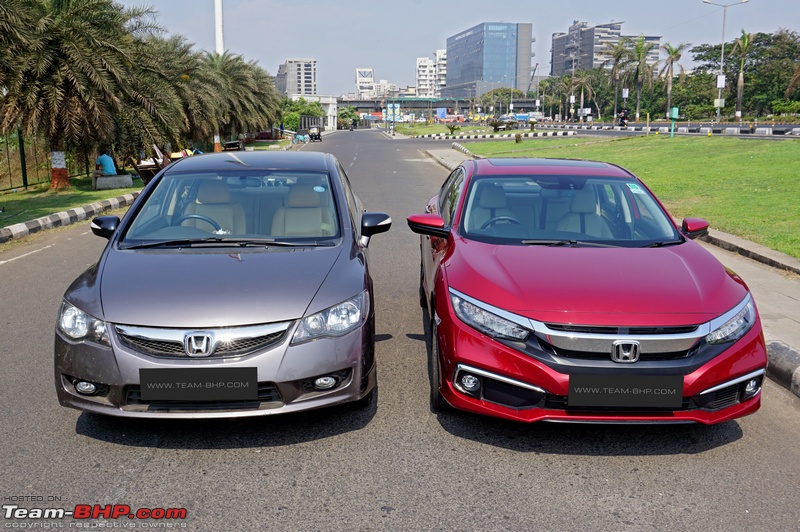 At the back, the old car has a cleaner look compared to the current-gen's edgy design: 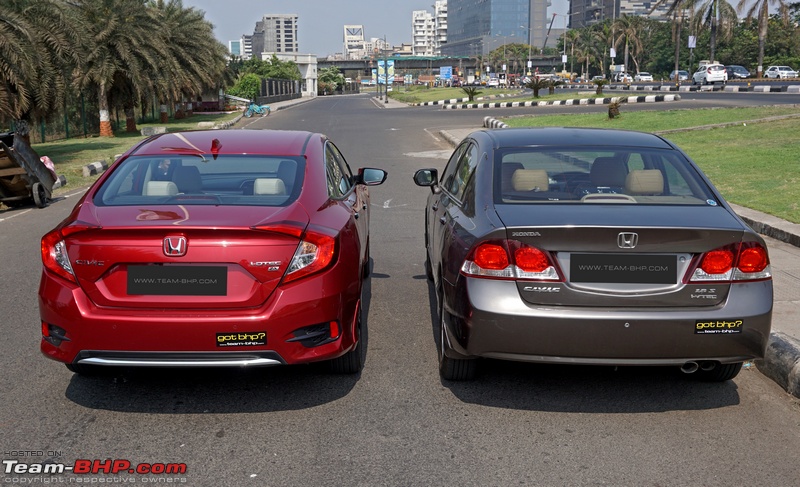 From a sedan to a coupe-like shape over 2 generations: 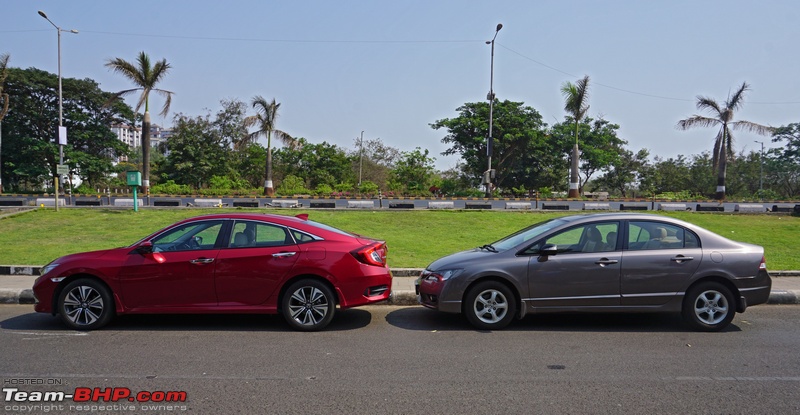 Last edited by Aditya : 16th July 2019 at 14:43. |
| |  (52)
Thanks (52)
Thanks
 |
| The following 52 BHPians Thank blackwasp for this useful post: | akshay81, AutoIndian, AYP, Bee, BigBrad, blackasta, CrAzY dRiVeR, cule1899_bhp, Cyborg, Dr.AD, Gaboonviper04, ganeshb, GTO, hmansari, InControl, jailbird_fynix, keroo1099, Klub Class, lemedico, manim, MotorDev, Motor_Nut, N33raj, nair, neil.jericho, Nohonking, Obi-Wan, phoenixash, PraNeel, PrasunBannerjee, pritanshchandra, RaghuVis, RavenAvi, Redline6800, sayakc, Scorpion 10, Simat, Simhi, SnS_12, sumeethaldankar, sunny29584, Sunny_team_bhp, theexperthand, THE_DRIFTER, The_Outsider!, Tpsdhiraj, uday.ere, Vik0728, vredesbyrd, VTec_KickedInYo, Xaos636, yogiii |
| | #4 |
| Senior - BHPian | Interior - Front 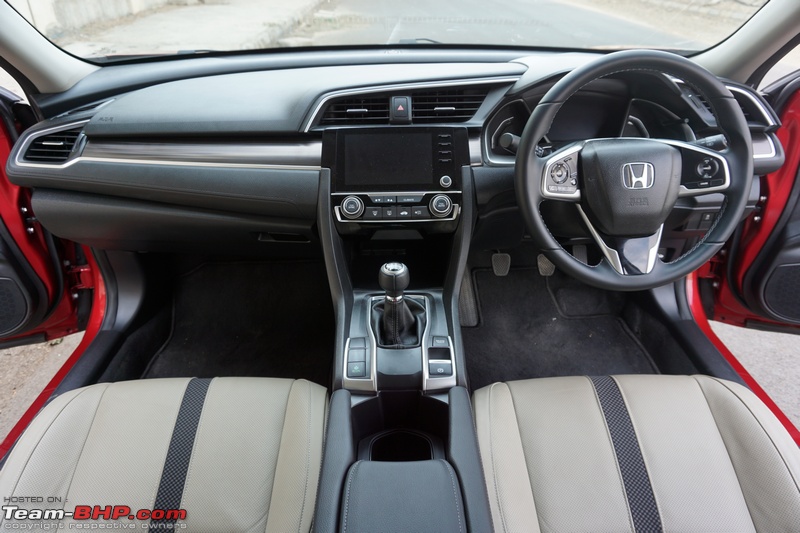 The front doors open wide in a triple-stage action and the door sill is narrow. However, ingress & egress are poor due to the low seating. Senior citizens will hate it. On the other hand, it leads to a very sporty driving position, which enthusiasts will like. It is as close to a sports car as you’ll get in a mass market sedan. Some of you will sit in a knees-up position though (especially in the passenger seat). As mentioned earlier, the doors have some weight to them & feel reasonably solid, but there is no German car thud while shutting them. Still, the Japanese have come a long way here. Get inside and you will immediately notice the premium cabin. It is bright & airy and the interior feels properly screwed together. The seats get leather upholstery and a fabric insert in the middle. The dashboard gets an all-black theme with silver, piano black and faux-metal inserts. I prefer this to the Octavia's beige and black treatment. The center fascia is angled towards the driver too. We like the dashboard's design. As is the norm for a car from this segment, the Civic gets soft touch plastics on the top of the dashboard, as well as the door pads. Honda hasn't cut any corners here and the interior quality is good overall. However, it is not the segment best. The Octavia is superior. The ergonomics are spot on, as is the case with most Honda cars. Things are just where you expect them to be. The all-round visibility is good too. However, it sure doesn’t feel like an all-new generation car. For one, the wheelbase is the same. The steering, gear shifter, A-pillar etc. are at the EXACT same place as the older Civic. Space wise, head and shoulder room are adequate at the front. Even 6-footers will be comfortable with the legroom. Dashboard gets an all-black theme. The dash top has soft-touch material. Piano black and silver inserts have been thrown in along with a faux metal strip. Ergonomics are spot on:  Frontal visibility is excellent. The bonnet bulges are visible for taller folks; many people like that. The dash isn't too high and shorter drivers will be comfortable as well:  Chunky 3-spoke steering wheel gets a leather wrap and is amazing to hold. It has thumb contours & piano black inserts. Horn pad is easy to press, although those with shorter fingers might find reaching it a bit of a stretch:  Left spoke houses controls for the infotainment system & telephony. The disconnect button doubles up as a back button. There is no pause or mute button on the steering - sucks because we find a lot of utility in that feature. That said, keep the volume (-) button pressed and it will decrease the sound to 0 in a couple of seconds. Right spoke houses the cruise control buttons. All the buttons are clicky and offer good feedback:  Zooming in on the piano black + silver inserts on the third spoke:  Steering gets tilt and telescopic adjustment - a much needed feature as it helps in getting the perfect driving position:  VX and ZX variants get a sporty and modern 7-inch digital instrument cluster, with a digital speedometer and tachometer in the middle and a fuel and temperature gauge on either side. Speed is displayed in a large font while the lettering of the rev counter is on the smaller side. Unlike the 8th-gen car, this time around, there is no speedometer at the driver’s eye level, on top of the dashboard (link to image):  Ugly stalk is used to toggle between the trip meters. Looks terribly out of place in a car from 2019:  Couple of screens when you start the car. It's a bit gimmicky, but the animation looks cool; not your traditional needle-swipe intro:  The MID displays outside temperature, odometer and the clock at the bottom. The middle section displays information according to the user's choice. The Civic gets 2 trip meters:  Press the 'i' button on the steering to toggle though the various screens. These include fuel and trip information, music, phone, a blank screen and navigation:  The fuel screen shows the distance to empty and averages of trip A and B. Trip information reveals average speed and travel time. Music screen allows you to select various sources like FM, Bluetooth, USB etc. as well as change radio channels, songs etc. Phone screen will show recent calls and allow you to dial a contact. Navigation screen will show Google Map directions (via CarPlay / Android Auto):  All buttons & controls feel solid & durable, including the light and wiper stalks. Only the ZX variant gets automatic headlamps and rain sensing wipers. Tap the indicator lightly and it activates the 'lane change' feature, with the indicators flashing thrice. Lane watch camera works brilliantly. The camera starts the minute you put on the left turn-indicator. You can even start the camera without turning left (via a button on the stalk). Lane watch can also come in handy while parking. Foglamp switch is located on the light stalk itself:  Pressing this button on the light stalk activates the lane watch camera. Likewise, turning on the left indicator also turns it on. Must say the display on the head unit comes up pretty fast once you engage the left turn-indicator. There is no lag. Very useful too:  Engine start/stop button gets a silver ring around it and sits to the right of the steering wheel. It glows red when the car is in accessory / ignition modes or when the engine is running. Opening the doors also has it glowing in red. It is white at other times:  Trapezoidal side air vent with a silver surround looks good. Side vents get air volume control as well:  Two spots in a sea of blanks are occupied by the headlight leveller and the traction control button. The blanks sure look awful: 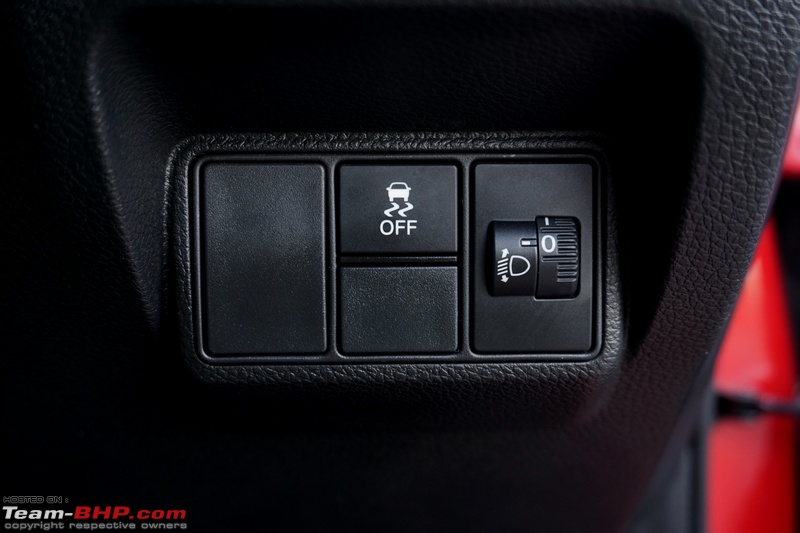 Bonnet release lever is located next to the footwell:  Doorpads get a beige + black colour theme. Armrest gets black leather which is preferred to prevent soiling. A silver insert adds a premium touch. Soft touch plastics are used at the top of the door pad. The lower portion is black, which is easier to maintain compared to a lighter shade:  Door handles are finished in a sweet silver and have a nice amount of weight to them. Car gets auto locking which is welcome. Further, the doors lock automatically when you walk away with the key. We had first seen this in the Captur. Notice the multiple material textures & colours of the doorpads:  All windows get auto up & down with anti-pinch function in the VX and ZX variants. V variant gets auto up & down with anti-pinch functionality for the front windows only. All the buttons are illuminated in white. At the top are the controls for the mirror adjustments. They can be folded electrically:  Black armrest as well as the beige area on the side is finished in leather. Black is a better choice as it doesn't get soiled easily:  Door pockets can hold a 1L bottle each as well as other small items. The rear portion is not very wide and extends inside the doorpad. Accessing items stored in it could be tricky for those with larger hands:  Oddly, the boot open button is placed on the door pocket, ahead of the bottle holder:  Door sill isn't very wide, making ingress easier. No scuff plates provided:  Leather upholstered seats are well-contoured. Side bolstering gets sufficient padding and unlike some cars, it will not bother individuals with a healthy build. Under-thigh support at the front is average and might vary depending on your height. Be sure to consider this factor first. Enthusiasts will like this low seating, but the aam junta won't. The driver's seat can at least be adjusted for height, but not the passenger's seat. Further, lumbar adjustment is missing in the Civic and despite having good backs, both GTO and I, got lower back pain. We can't remember any car giving us back pain in the last 5 years:  8-way electrically adjustable driver's seat. Lack of lumbar adjustment is especially shocking considering the back pain:  Front passenger has to make do with a manual recline adjustment lever...  ...and fore-aft adjustment rod. No height adjustable seats for the passenger. The front passenger will be forced to sit low as his seat doesn’t have height-adjustment like the driver’s. If tall, he will be forced to sit in a knees-up position (unless he takes the seat all the way back and stretches his legs). In a car with such low seating, the front passenger seat MUST get height adjustment. Sad that Honda’s engineers missed something that is so obvious to laymen like us: 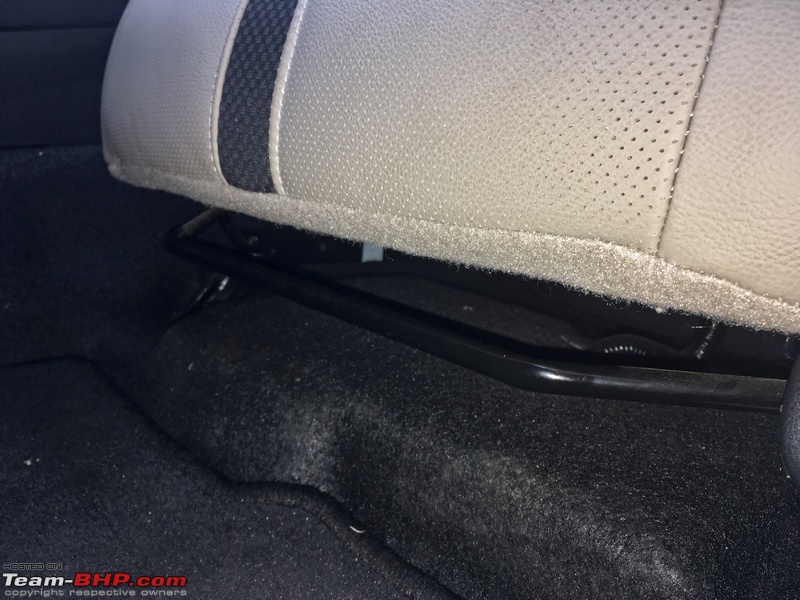 Fore & aft adjustment is sufficient even for 6 footers:  Height adjustment range is also healthy. Finding your perfect driving position is easy. Do note that the ZX comes with a sunroof that eats into the headroom. If you are tall, be sure to consider this factor first. At 6 feet tall, I didn’t have any issue though:  Large, adjustable headrests are soft:  A close look at the seat upholstery. The leather is of good quality and gets perforation (only front seats), while the fabric portion gets a chequered pattern. The dark stripes make it too formal and don’t suit the sporty design of the Civic. Thankfully, these stripes are only on the front seats:  Seatbelts get pretensioners & load limiters and can be adjusted for height:  ABC pedals are properly spaced out and a dead pedal has been provided as well. It is possible to comfortably rest one's left foot on the dead pedal:  Civic-branded floor mats are black in colour, as is the car's main carpeting below. Easy to maintain:  ORVMs are sufficiently tall and wide:  IRVM with auto-dimming functionality covers the whole rear windscreen:  Visibility while reversing is average. Tapering roof, tall boot and the headrests contribute to this. The quarter glasses help matters. However, reversing aids are a must:  Center fascia is slightly tilted towards the driver: 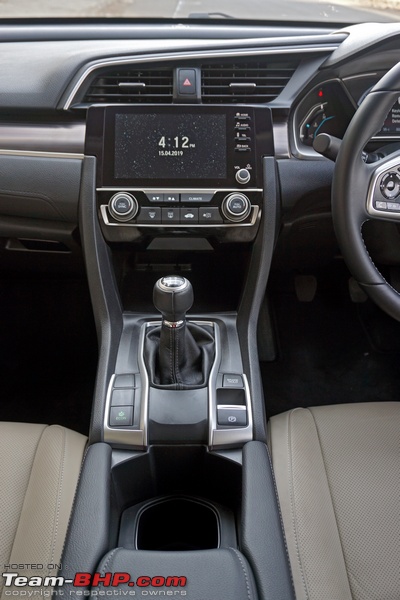 Center air-con vents are differently sized. They can't be shut off like the side units: 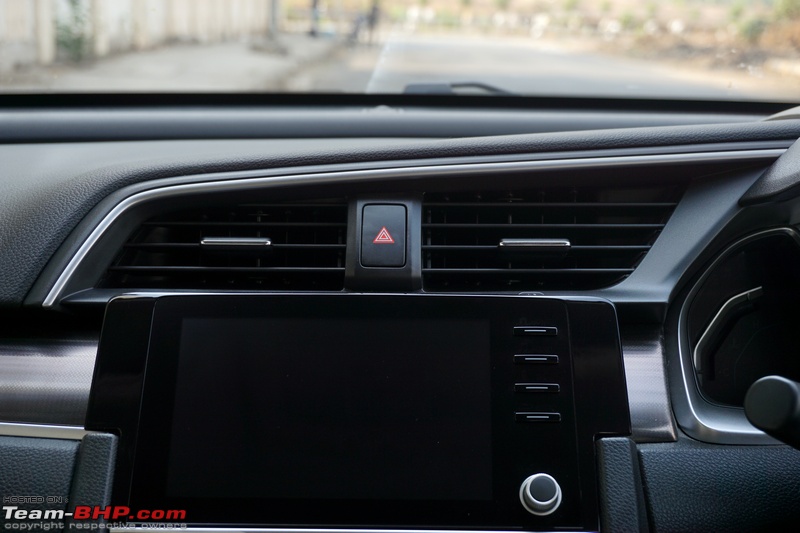 7-inch touchscreen head unit gets Android Auto and Apple CarPlay. It gets USB and Bluetooth functionality. The right side gets few physical buttons and a volume control knob. More details in a dedicated post later:  Dual-zone climate control system. Even on a hot day, the air-con managed to keep the cabin cool (as is the case with Hondas):  Center console has double decker storage. Panel ahead of the gear level can be used to park your phone. International versions get wireless charging here:  Civic gets cable management to connect your phone to the HDMI and USB ports that are below. The idea is you invest in cables and thread them into the main front deck where you plug your phone in while driving. See how the phone holder has gaps for the cables:  12V power socket is placed low on the center fascia on the left... 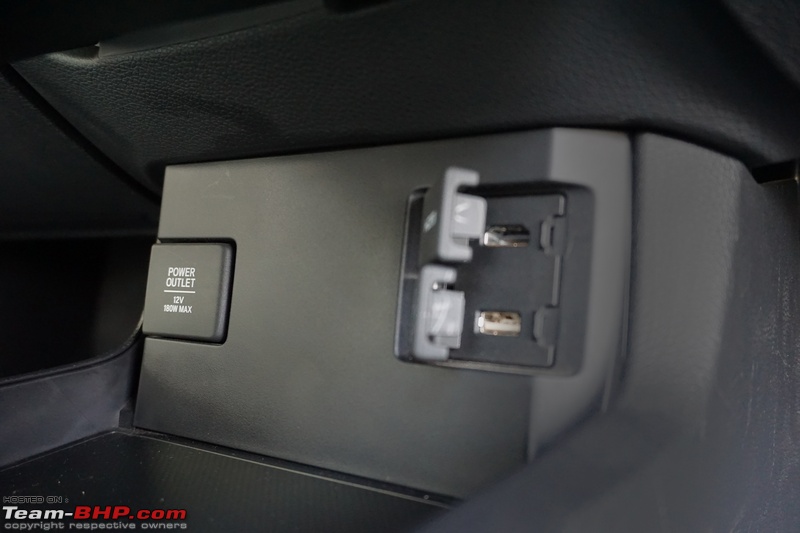 ...while an HDMI and a 1.5A USB port are located on the right (we feel this HDMI port is useless). These ports are placed out of sight and are cumbersome to access:  You can also leave your phone in front of the ports. 4-inch smartphone for scale:  Small pocket on the driver's side of the center console:  As there isn't a conventional hand brake, lot of space is freed up. Two cup holders are provided - the front one is fixed while the one behind can be removed based on requirement: 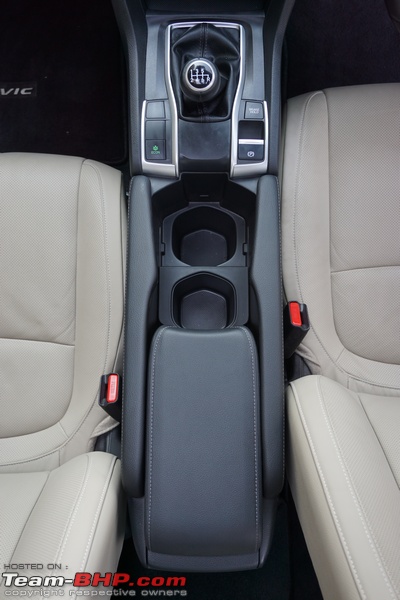 ECON switch is placed to the left of the gear lever. It dumbs down the engine and air-con performance to maximise fuel efficiency. Two dummy buttons are provided above the ECON button. In global markets, the Civic gets its engine start/stop button above the ECON button. E-brake and the auto hold buttons are placed on the right. The automatic brake hold function retains brake pressure when the vehicle comes to a stop at, say, a traffic signal or in stop-go traffic. The driver is able to take his foot off the brake pedal once the car has stopped, without the car rolling forward or backward: 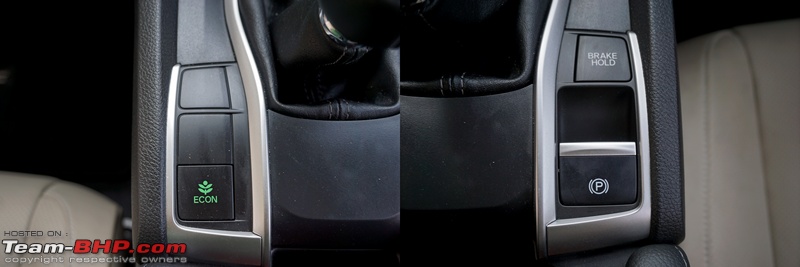 Armrest is well positioned and can be adjusted by sliding forward or backward. It cannot be adjusted for height though: 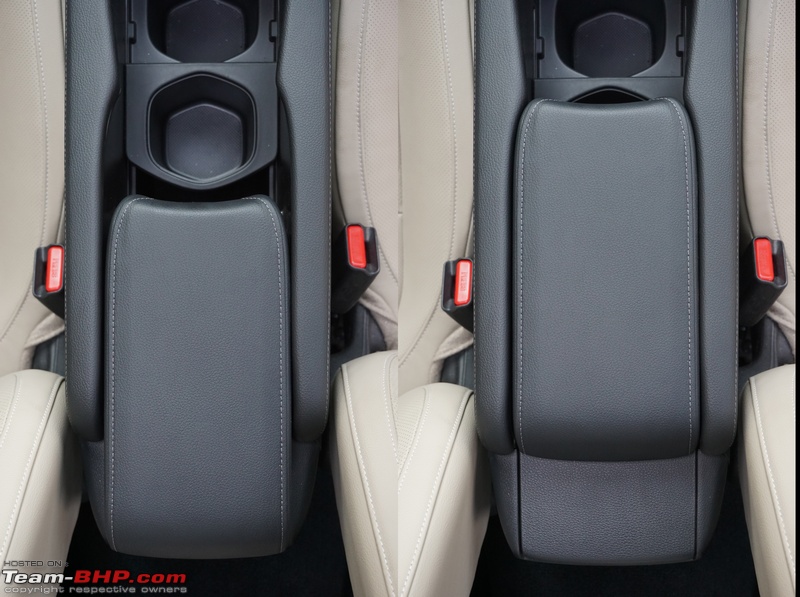 Opening the armrest reveals a large felt-lined storage bin. This much space has been made available thanks to the use of an e-brake. A conventional handbrake lever would eat up a lot of space here: 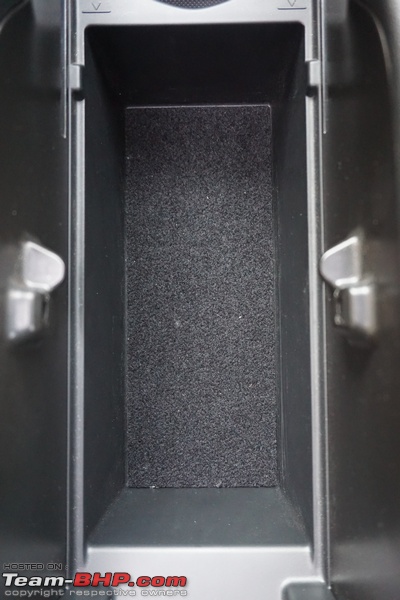 There is a 1A USB charging port provided on the rear wall of the bin just below the lid:  Faux-metal + silver insert on the passenger side of the dashboard: 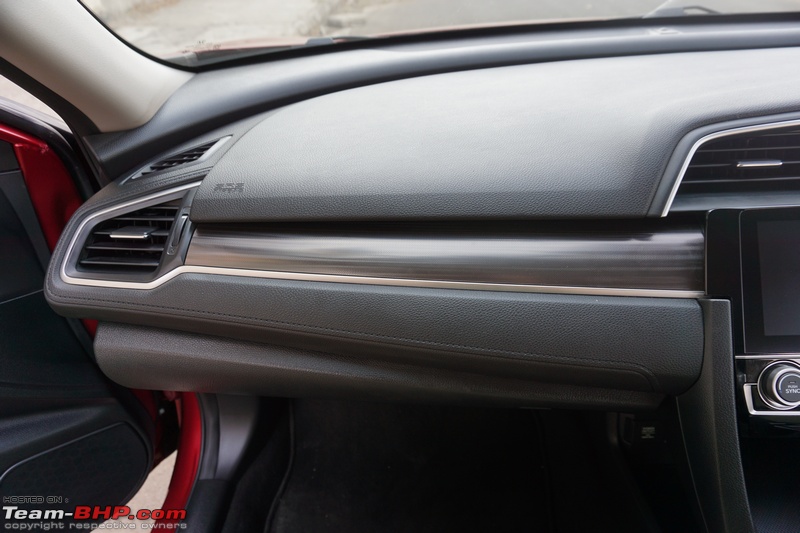 Glovebox is decently sized and its lid has a damped action. No compartments have been provided though. While the glovebox gets illumination, a cooling vent has not been provided: 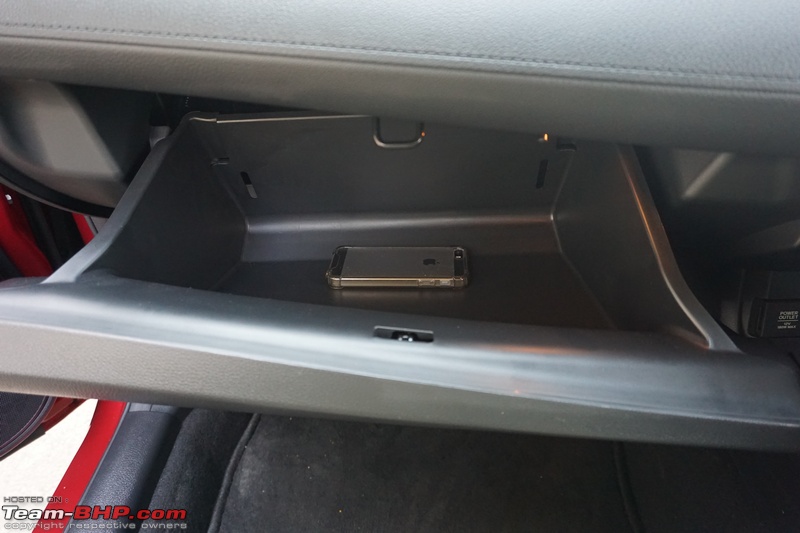 Roof bezel houses the cabin lamps as well as the sunroof controls. Bluetooth mic is located next it. Grille between the sunroof and light switches is a dummy unit: 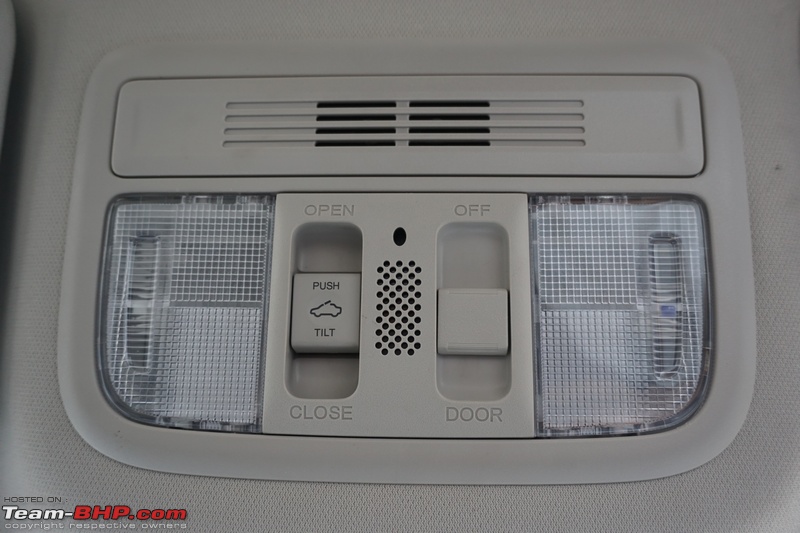 Both sunvisors get illuminated vanity mirrors with covers: 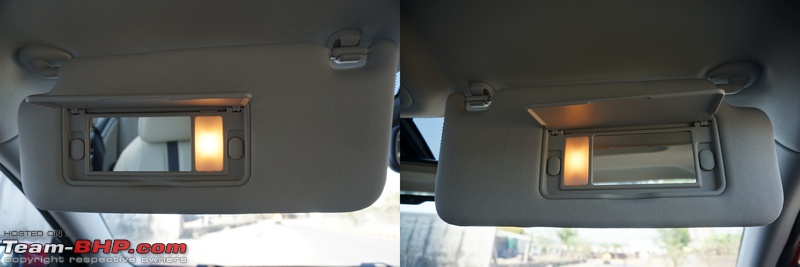 Airbag warning stickers on both sides of the passenger sunvisor:  Driver-side unit gets a ticket holder: 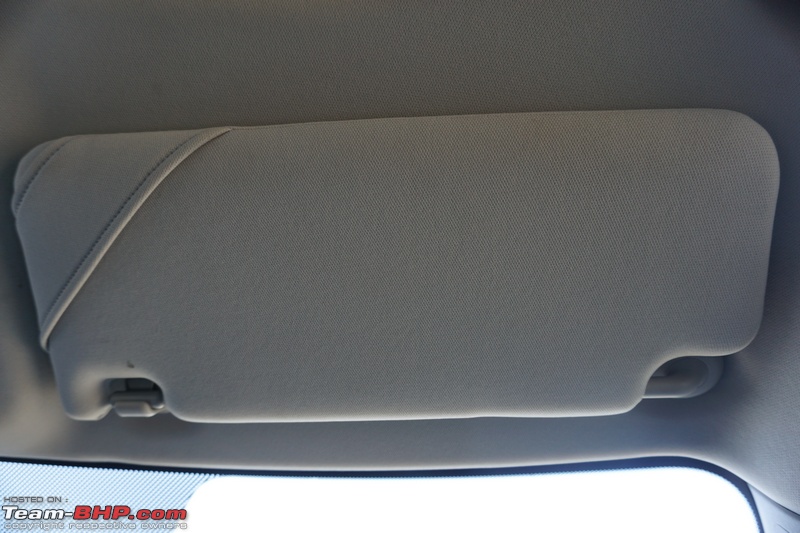 The size of the sunroof is just adequate for the cabin: 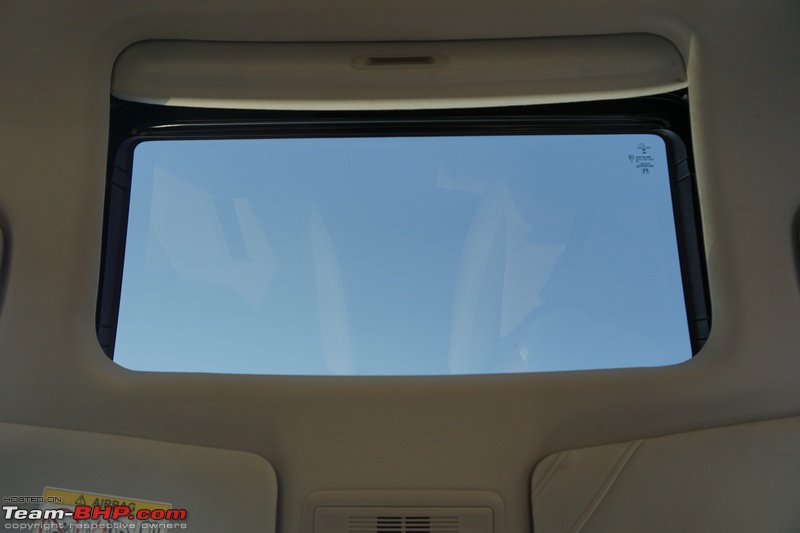 Manual sliding cover for the sunroof: 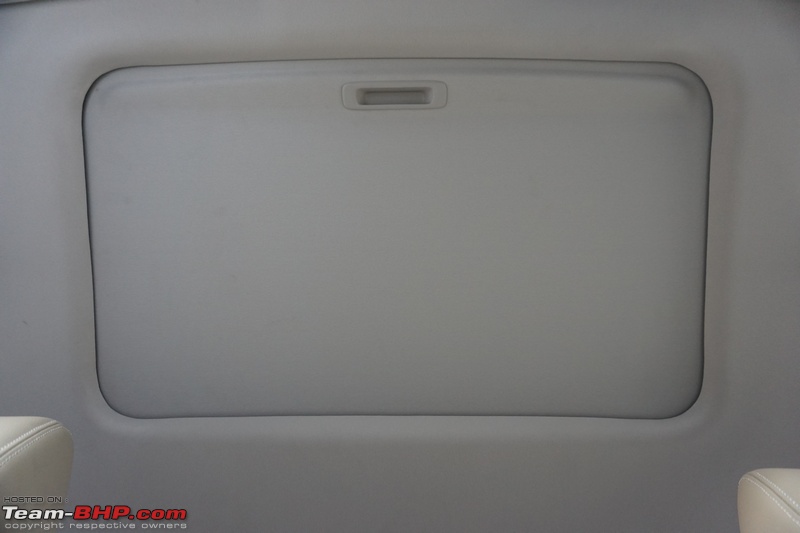 With the sunroof open, a lot of light comes into the cabin. This is the max it opens to:  Wind defector rises as soon as the sunroof is opened: 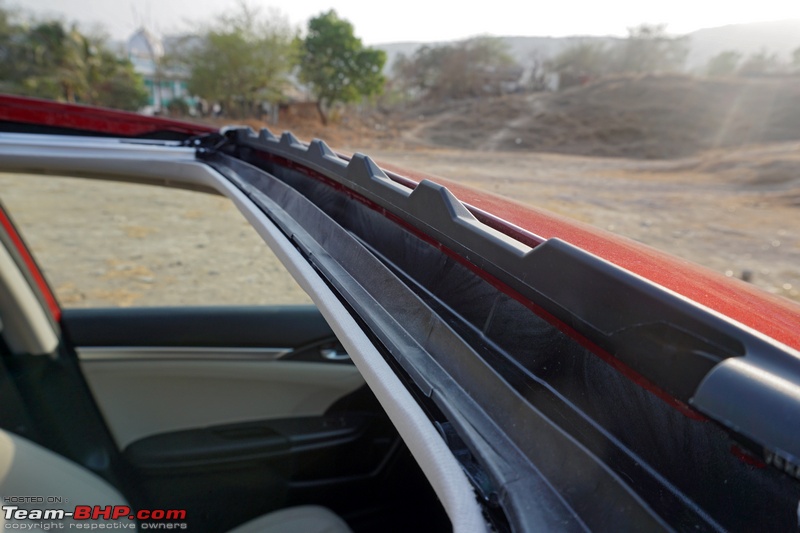 4 grab handles have been provided, including one for the driver:  Dual front and front side airbags are standard across the variants:   ZX variant gets curtain airbags as well:  Things are neat and tidy even in places where most people won’t ever bother to look. There are no loose wires or cables dangling anywhere. Here's a look under the dashboard in the driver footwell... 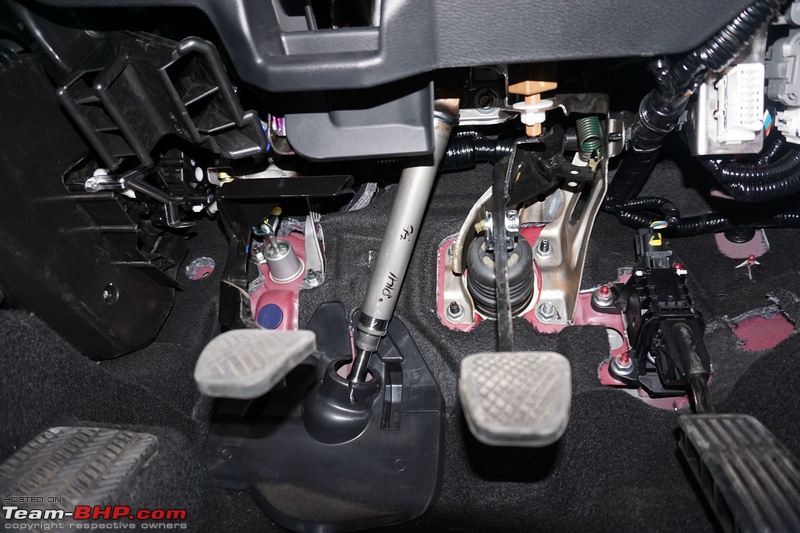 ...and the passenger footwell: 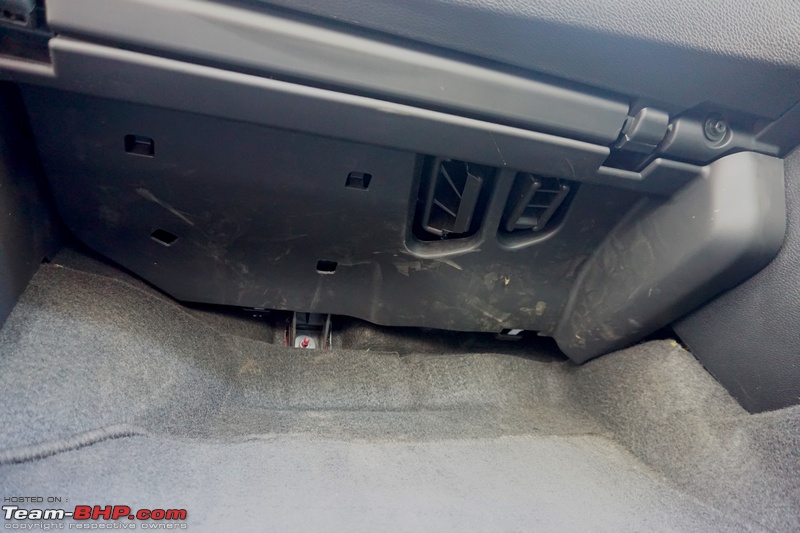 Last edited by Aditya : 16th July 2019 at 14:44. |
| |  (32)
Thanks (32)
Thanks
 |
| The following 32 BHPians Thank blackwasp for this useful post: | akshay81, AutoIndian, AYP, blackasta, Carzman, CrAzY dRiVeR, Cyborg, Dr.AD, Gaboonviper04, GTO, Ithaca, jailbird_fynix, keroo1099, Klub Class, lemedico, neil.jericho, Obi-Wan, phoenixash, PraNeel, PrasunBannerjee, RaghuVis, RavenAvi, Redline6800, Simat, Simhi, SnS_12, sunny29584, THE_DRIFTER, The_Outsider!, uday.ere, VTec_KickedInYo, yogiii |
| | #5 |
| Senior - BHPian | Interior - Rear Rear doors open in a two-stage action and sufficiently wide. However, the roof starts tapering towards the rear part of the door and coupled with the low seat, getting in and out is still a task. Passengers will hate the ingress & egress:  Gap between the B-pillar and the seat is also on the narrower side, making stepping in and out difficult:  Only a fraction of the actual door sill is usable. Again, combined with the low seating, it makes getting in and out difficult, especially for elders:  Like the front, the rear doorpads get a dual-tone beige & black theme:  Rear door pocket has a larger opening than the front and can accommodate a 1L bottle and other knick-knacks:  Contoured seat with a comfortable recline angle. Thanks to the contours, seats are comfortable for two occupants and not three:  All 3 passengers get 3-point seatbelts, while only the outer two get adjustable headrests. Also note the raised backrest where the fifth occupant would sit. Things aren’t ideal for the middle passenger:  Two 6-footers, one behind the other? No problem. This is the maximum & minimum legroom available:  With the front seat adjusted for my driving position (I am 6'), I have a good 5 inches of knee room. With the seats pushed all the way back, I still have some knee room to spare:  The front seats are raised, allowing rear passengers to comfortably slide their feet below them. The lower portion of the seat is covered in a soft material that will prevent hurting the shins:  Seatbacks of the front seats are scooped out a little to release more knee room at the rear:  The rear seat offers sufficient cushioning. However, thigh support at the rear is only average due to the low seating. Headroom too is limited for tall occupants. See how there is barely any space left with 5' 10" Aditya sitting!!! A 6-footer will brush his hair against the roof when sitting slightly upright. Headrests are usable though. We would say that the City’s rear seat is probably more comfortable overall:  Armrest is soft, wide and comfortable to use. Two cup holders of different sizes are provided. No audio controls on the rear armrest like in the old Civic: 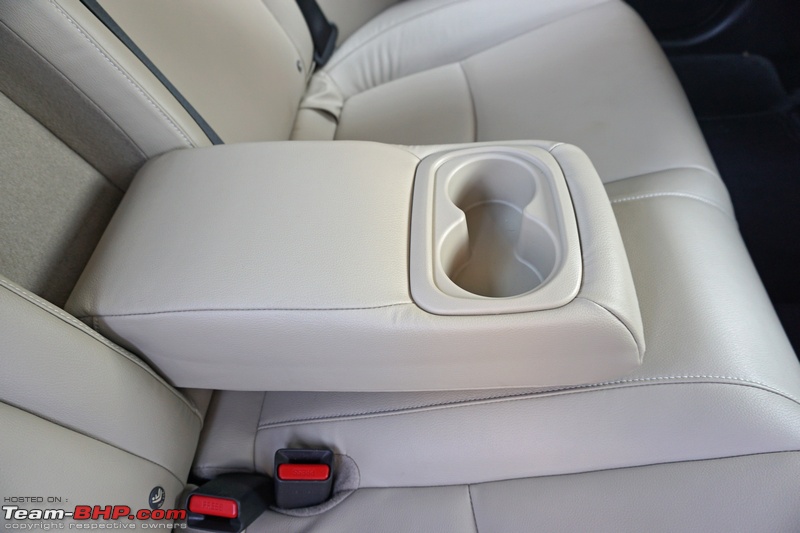 The armrest slopes downward and rests on the seat base. It could have been placed slightly higher up to be better positioned for taller occupants to use comfortably:  ISOFIX child seat anchors are present on both sides and offered as standard on all variants. The anchors are neatly concealed under pieces of leather:  Top tethers for the child seat get plastic flaps. The mounting points are body-coloured. They are attached to the monocoque of the car:  Parcel tray slopes downward towards the rear seat. It cannot be used to store things as it does not get a lip to prevent them from rolling onto the seat. We prefer this as it prevents passengers from keeping things here, which can obstruct the driver's view or slide around while cornering:  Glass area lets in a good amount of light. This, combined with the beige colour, gives a feeling of roominess. That said, shorter passengers could find the window line high and the view outside restricted:  Quarter glasses further help in letting more light in:  Rear window doesn't roll down all the way. This is the maximum it can roll in:  Two seatback pockets provided. They are wide, spanning the entire width of the seats. These are the best places to dump miscellaneous items in:  Rear cabin lamp has 3 positions - on, off & door (in the middle). It's placed above the feet of the rear passengers:  Spring-loaded grab handles provided above all four doors. The rear right passenger also gets a coat hook:  No rear USB or 12V power outlet for the rear occupants (the cheaper Amaze offers a 12V socket). Rear air-con vents get independent flow direction controllers, but a common air volume controller:  Floor hump is tall and wide - not good for the center passenger who will have to place his feet on either side of it. The 8th-gen Civic had a flat floor, while this doesn't:  430L boot is the smallest in the segment, yet we found it to be usable. The mouth is wide and the lip is not too high, making it easy to load luggage:  Boot lid gets full cladding on the inside:  Single lamp provided in the boot. Naked hardware around it is an eyesore:  Slide your fingers inside this opening to lift the boot floor:  Spare wheel is a full-sized alloy unit:  Tools are neatly arranged in a Styrofoam casing:  Small trays under the boot floor can be used to store small items out of sight:  The boot floor can be propped up to hold it in place when you are changing a tyre:  Last edited by Aditya : 16th July 2019 at 14:44. |
| |  (32)
Thanks (32)
Thanks
 |
| The following 32 BHPians Thank blackwasp for this useful post: | AutoIndian, AYP, blackasta, Carzman, Cyborg, Dr.AD, Gaboonviper04, GTO, InControl, Ithaca, jailbird_fynix, keroo1099, Klub Class, lemedico, neil.jericho, Obi-Wan, PapaKiloSierra9, phoenixash, PraNeel, RaghuVis, RavenAvi, Redline6800, Simat, Simhi, SnS_12, sunny29584, Sunny_team_bhp, THE_DRIFTER, The_Outsider!, uday.ere, VTec_KickedInYo, yogiii |
| | #6 |
| Senior - BHPian | In-Car Entertainment The Civic comes with a 7-inch touchscreen head-unit (same as the CR-V). The ICE interface feels 5 years too old today. Luckily, it has Android Auto & Apple CarPlay that feel more “with the times”:  Head-unit actually runs off Android OS:  It gets 2.34 GB of internal space (for apps, media and wallpaper):  Music is played through a tweeter on each of the front doors...  ...along with a mid-bass speaker on the front doors...  ...and parcel tray-mounted dual mid-bass + tweeter combination speakers (total of 4 speakers and 4 tweeters). The sound quality is average and nothing special like the Octavia's Canton music system. Distortion at high volume is well controlled and the sound remains clear:  The touchscreen gets a matte texture that minimises glare. The screen resolution is good. Notice the 4 physical buttons on the right - Home, Audio, Telephone and Back. At the bottom is a tiny volume dial, which can be pressed to turn the system on or off:  Music can be played from various sources including FM / AM radio, USB, Bluetooth, iPod, Smartphone, Audio Apps and HDMI:  Now playing screen displays the album, song, artist as well as the source:  Sound settings include the usual equaliser settings...  ...as well as balance and fader settings:  Speed dependent volume can be configured as well:  Other settings include screen order, configuration of the instrument cluster, tachometer settings, display settings and background colour:  Display settings include touch panel sensitivity, guidance volume, voice recognition volume, beep volume and clock / wallpaper type:  Wallpaper / clock settings can be configured from here. The selected wallpaper and clock are displayed:  The settings include clock adjustment, format (12/24 hours), clock on/off and the overlay clock position (the one seen at the upper right corner of the screen)...  …as well as clock reset and info screen preference:  One can also adjust the climate control from the ICE display too. Frankly, it’s pointless – we prefer the knobs to make adjustments on the fly, especially when driving:  You can choose the order of items in the instrument panel:  Add / delete them according to your choice:  Current drive shows the fuel economy as well as that of the previous drive:  The trip computer not only reveals the distance travelled and fuel economy of the current drive, but also the summaries of the previous 3 drives. The history can be deleted as well:  Tachometer can be turned off (though I'm sure most enthusiasts will not like it):  A look at the instrument cluster with the tachometer turned off:  Some of the other settings:    Very good feature - with the key in your pocket, the car locks itself when you walk away: 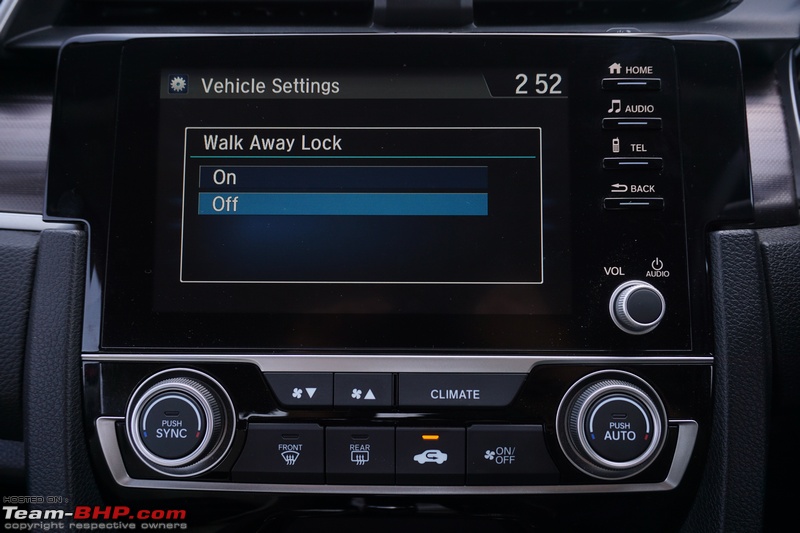 If you forget to lock the car, you can even set a timer that will lock the car automatically after a set time:  A calculator can be accessed as well:  You can add speed dial numbers here and view the history as well:  Phonebook can be accessed via this menu. Handy alphabet-wise shortcuts are provided at the top:  Apple CarPlay and Android Auto are provided. To use them, connect your smartphone to the system via a USB cable:  Not all USB ports are enabled with smartphone connectivity. Only the one on the center fascia can be used for connecting to Android Auto / Apple CarPlay:  Apple CarPlay now comes with Google Maps:  You can get directions, make calls, send / receive messages and listen to music through the Android interface: 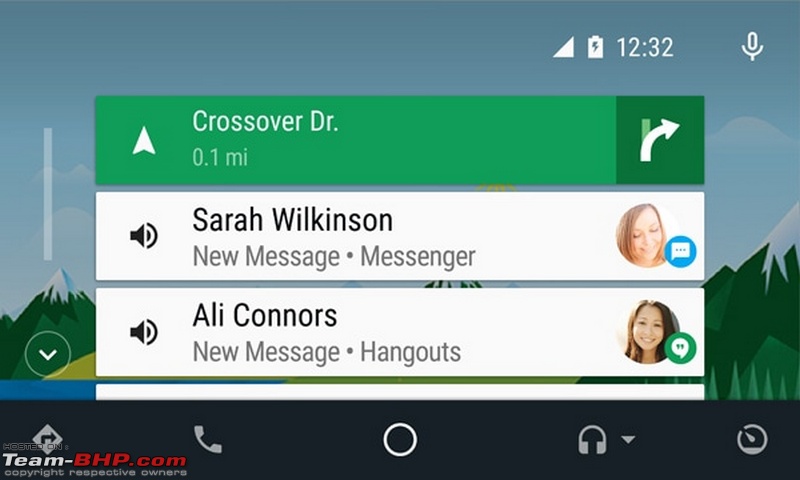 Implementation of Google Maps is better on Android Auto compared to Apple CarPlay - it is exactly the same as you would expect on your smartphone: 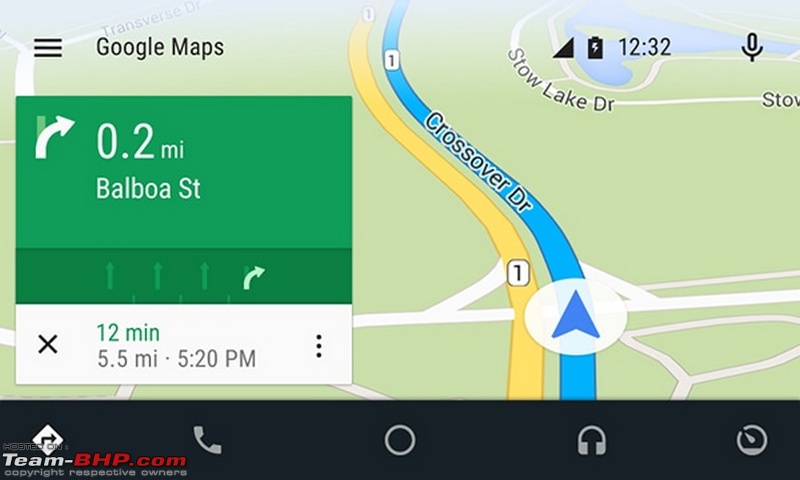 Head-unit doubles up as a display for the reverse camera. Daytime visibility is good and adaptive guidelines have been provided. Besides, you get to choose between normal view... 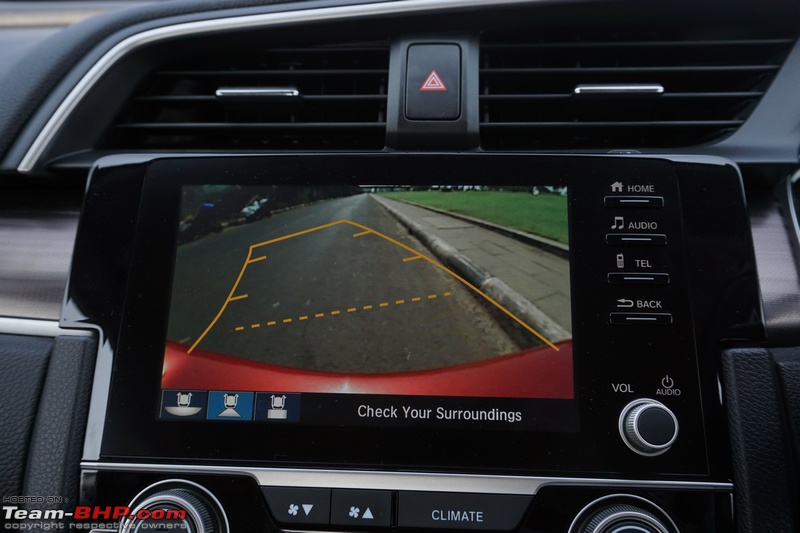 ...a wide-angle view...  ...and a top down view when manoeuvring into tight spots:  A look at the camera display at night. The quality is not very good, but gets the job done:  Touchscreen also acts as a display for the lane watch feature. This feature can also come in handy while parking:  The lane watch camera is useful at night as well, but in case the car behind is using high beams, it will blur the display:  Settings for the reverse camera...  ...and the lane watch camera:  Last edited by Aditya : 16th July 2019 at 14:46. |
| |  (29)
Thanks (29)
Thanks
 |
| The following 29 BHPians Thank blackwasp for this useful post: | AutoIndian, AYP, blackasta, Carzman, CrAzY dRiVeR, Cyborg, Dr.AD, DrANTO, Gaboonviper04, GTO, InControl, jailbird_fynix, keroo1099, Klub Class, lemedico, neil.jericho, Obi-Wan, phoenixash, PraNeel, RavenAvi, Redline6800, sachin_cs, Simat, SnS_12, THE_DRIFTER, The_Outsider!, uday.ere, VTec_KickedInYo, yogiii |
| | #7 |
| Senior - BHPian | Driving the 1.8L Petrol CVT  The Civic gets the same 1.8L naturally aspirated petrol engine as the 8th-gen car, but compatible with BSVI emission norms. It makes 139 BHP @ 6,500 rpm & 174 Nm @ 4,300 rpm and is paired with a continuously variable transmission (CVT) with paddle shifters. The old Civic's torque converter AT was better than this (it had paddle shifters as well). On the other hand, the CVT is expected to be more fuel-efficient. To start the car, put the gear shifter in P or N and with the driver’s foot on the brake pedal, press the engine start button. The gear shifter has 5 positions – P, R, N, D and S. As mentioned earlier, paddle shifters have been provided behind the steering wheel. However, being a CVT, the infamous rubber-band effect is present. Forget this petrol + CVT combo if you are an enthusiast. This is only for the very sedate drivers. Performance is like what you would expect in the C2 segment, not in the D1 segment. The speed is nowhere as effortless as in the Octavia 1.8 TSI. Heck, forget the Octavia, the Elantra Petrol AT feels better to drive. The Honda engine is rev-happy though. The car feels very competent in urban surroundings. It’s beautiful to drive in the city if you are a sedate driver. To begin with, the drive is very smooth thanks to the seamless CVT, while the refined i-VTEC engine makes it incredibly relaxing within city limits. The Civic doesn't feel laggy and there is sufficient grunt to get you moving. The response to throttle inputs is good and the CVT is butter-smooth in traffic. If you are a relaxed driver, you will love the CVT and engine in the city. Moving away from a standstill is very smooth and seamless. The car crawls at 6 km/h with no accelerator input. With a light foot, the experience is refined & noise levels are kept low. The Civic makes for a great urban commuter. But yes, even within the city, if you want to close a gap to the vehicle in front and floor the throttle, you will experience the infamous rubber-band effect. While the revs go up, the actual speed doesn't. On the open road, until mid-intensity accelerator inputs, the rubber-band effect is controlled. Performance is reasonably peppy too. On the downside, start getting heavy with your accelerator inputs and the driving experience becomes awfully annoying. The rubber-band effect is very prominent when flogged hard. The response sometimes takes a good 2-3 seconds in ‘D’ mode and it's best to prepare the car before your overtaking manoeuvers. What you can do is use the paddle shifters, drop a gear or two and floor the accelerator. One more good thing about using the paddles is that you can shift down and get healthy engine braking, especially in the ghats. Basically, this engine and gearbox combination is good for everything except enthusiastic driving and overtaking. On ghat sections, the ‘D’ mode feels particularly lethargic and needs a heavy foot to get going (I preferred ‘S’ mode here). On the expressway, if you want performance, you have to work the engine and gearbox hard. It's a good thing that it's rev-happy, as you need to push it hard to extract performance. The power delivery is not effortless like it is in the Octavia 1.8L DSG. Performance is par for the course. While the engine does its job, it's not explosive and does not leave a positive impression. The CVT is at home with a gentle & easy driving style only. You need to be a calm driver behind the wheel of this car. The actual performance is acceptable and the Civic CVT accelerates all right - the engine's strong top-end is the saving grace, but I still didn't enjoy pushing this car due to the CVT's behaviour & weak mid-range. On the highway, you start to enjoy this engine only after 5,000 rpm. This is unlike cars like the Octavia 1.8, where even at 3,000 rpm, you floor the accelerator and there is instant response. It's not something that is entertaining all throughout the rev range. Again, don't get me wrong, it's not slow, but it's not fast either. And when you are spending 20 big ones, you need something special - neither the diesel nor the petrol CVT offers you that. For travelling long distances, the CVT's ability to cruise in a relaxed manner is remarkable. 100 km/h comes up at just 1,750 rpm, while 120 km/h is seen at ~2,000 rpm. 'S' mode keeps the engine revs higher. In ‘S’ mode, 100 km/h and 120 km/h come up at 3,000 rpm and 3,250 rpm respectively. 'S' mode can be very useful in preparing the car for overtaking (before actually making the overtaking move). It also gives you some more engine braking. But, don't be fooled - the S mode isn't sporty! The Civic comes with an "auto hold" function. When engaged, the brake pressure is retained when the vehicle comes to a stop at, say, a traffic signal or in stop-go traffic. The driver is able to take his foot off the brake pedal once the car has stopped, without the car rolling forward or backward. This is very convenient indeed. The CVT should provide acceptable fuel economy in the city as long as you maintain a light right foot. Honda has tuned the gearbox for economy and it's very obvious from behind the wheel. The CVT keeps the revs as low as possible when driving normally. The car's ARAI fuel efficiency rating is 16.5 km/l. Expect single digit FE in the city. In terms of NVH, the cabin is refined at regular rpm levels & cruising speeds. Things do get loud after 3,000 rpm though. The enthusiast might like the sound of a high revving petrol engine, but regular Joes won't. It gets very boomy in the 5,000-6,800 rpm range. Transmission whine is also audible when the engine is made to work hard. Wind noise is well controlled, but the tyre noise is on the higher side, especially when driving on concrete roads. i-VTEC makes 139 BHP & 174 Nm that gives it a power-to-weight ratio of 110 BHP / ton and a torque-to-weight ratio of 137 Nm / ton. Engine oil dipstick has an orange handle:  Insulation sheet has been provided under the bonnet of both engines:  Firewall insulation is thick:  One of the rare cars to get a solid metal plate for underbody protection  : : Fuse box cover gets some spare fuses and a handy tool to remove them:  The ECU is mounted at the highest possible position, towards the front of the car:  Upward facing intake might look odd, but the bonnet gets a rubber guide to push the air into the intake:  Standard P-R-N-D-S shifter with a piano black console:  Gearknob is wrapped in leather. It has a silver insert and a chrome ring at the base. Good to hold:  Gear shifter has an "unlock" button. Good for safety. Gear lever comes with a leather boot as well:  No clutch pedal means more space in the footwell. Dead pedal is provided and very comfortable to use. There was no back pain experienced while driving the automatic. This is probably because in the manual, the left leg is busy with the clutch. In the CVT, it is resting on the dead pedal, thereby giving better support to the body:  The paddles, though plastic, are robust and good to use:  The MID displays the selected gear on the top left:  Pull the paddles in both D and S modes to manually get into the desired gear. While the change to M mode is temporary in D mode, in S mode it stays in manual mode:  Sticker on the inside of the fuel flap indicates the car's dietary preferences:  Last edited by Aditya : 16th July 2019 at 14:47. |
| |  (30)
Thanks (30)
Thanks
 |
| The following 30 BHPians Thank blackwasp for this useful post: | Anumon8448, AutoIndian, blackasta, chinmaypillay, CrAzY dRiVeR, Cyborg, Dr.AD, GTO, haisaikat, InControl, jailbird_fynix, keroo1099, Klub Class, lemedico, LONG_TOURER, neil.jericho, Obi-Wan, PapaKiloSierra9, phoenixash, PrasunBannerjee, RaghuVis, Rajeevraj, RavenAvi, Redline6800, Simat, Simhi, sunny29584, THE_DRIFTER, The_Outsider!, uday.ere |
| | #8 |
| Senior - BHPian | Driving the 1.6L Diesel MT  The Honda Civic diesel is powered by a 1.6L, 4-cylinder i-DTEC 'Earth Dreams' engine, which is paired to a 6-speed manual gearbox. The diesel engine shares its block with the 1.5L diesel found in the City & Amaze. In fact, we can say that the 1.5L engine is a smaller version of this 1.6L. This unit is an international motor, but the 1.5L is India-specific and made to suit our tax norms. The oil-burner produces "just" 118 BHP (@ 4,000 rpm) and 300 Nm of torque (@ 2,000 rpm) in the Civic and is BSIV compliant. The same engine does duty in the larger CR-V. There's a twin-turbo version available in international markets, which makes 158 BHP and 350 Nm of torque (40 BHP and 50 Nm more). Considering that the competition has 2.0L engines, Honda should have offered the higher 158 BHP tune in India as standard. The 158 BHP version of the engine is even manufactured in India for export markets!! The Civic weighs in at 1,325 kg, giving it a power to weight ratio of 89 BHP / ton and torque to weight ratio of 226 Nm / ton. These figures are lower than the Octavia, with which it directly competes. Transmission duties are handled by a 6-speed manual gearbox that sends power to the front wheels. In this segment, customers love their slush boxes. The decision to not offer an automatic is not a good one. Indians love their diesel automatics – heck, the far cheaper Amaze comes with a unique diesel + CVT combo! Press the engine start / stop button, keeping the brake pedal pressed and you are greeted by a diesel thrum. There is slight body shake on start-up as well as shut down, but no vibrations are felt on the pedals or the gear knob. The NVH levels in the Civic are far superior to those of the City. Honda has beefed up the insulation considerably. However, you don't associate a diesel thrum with the Civic since the car has always had silky smooth petrol power. It feels a bit weird at the start. The Civic diesel moves off the mark effortlessly. The 1.6's low end is superb & overall driveability is good. It also passes the 2nd-gear speed breaker test with no qualms. You won't be using the gear shifter too much in the city and depending on the traffic density, you could use either 2nd or 3rd like an automatic. There is some lag below 1,500 rpm, but it’s not excessive at all (the torquey diesel helps); you can start pulling the engine from a low 1,200 rpm itself. The Civic crawls at 7 km/h in first gear with no accelerator input; this can be useful in bumper-to-bumper traffic. Like the petrol, the diesel's performance is more “C2 segment” than D1. Straight line acceleration is decent. There is enough torque to get you going, and enough power to sustain it. But don't expect miracles. Overtaking is fuss-free, provided you are in the engine's power band. At higher revs, that "instant go" is missing. The engine simply doesn't have the grunt of the larger 2.0 diesel offered by the Octavia. This Honda is tuned for low end to mid-range performance rather than the top-end. Highway performance is average and the Civic's engine isn't as exciting as the Octavia's 2.0L diesel (141 BHP / 320 Nm). The Skoda remains the choice of enthusiasts, and VAG engines are easy to tune too. The i-DTEC redlines at a very conservative 4,500 rpm. Additionally, the engine doesn't sound or feel happy near the redline. You can also feel the power tapering off once the revvs cross 4,000 rpm. I must add that climbing up steep inclines & ghat sections is effortless due to the torque and the gearing. The Civic diesel is a competent highway cruiser. Those with a relaxed or sedate driving style will feel at home. The 6th cog helps and the car cruises on the expressway at 100 km/h with the engine turning over at a leisurely 1,750 rpm, while 120 km/h is seen at 2,250 rpm. The Civic diesel is also equipped with cruise control, which can be engaged over 40 km/h. The 6-speed manual gearbox is lovely to use. It has short throws and is precise slotting. The knob is good to hold as well. However, the diesel's clutch has some weight. It’s not as light as you would expect in a Honda. The Civic's fuel economy is impressive. At 26.8 km/l, its ARAI rating is the best in the segment. Like City diesel owners, those buying the Civic will be happy with the FE. This 1.6L diesel is a LOT more refined than the 1.5L of the City. NVH levels are satisfactory & cabin insulation is good. The car is noisy only on the outside (not on the inside). At speeds above 100 km/h, wind noise is well controlled. However, it's the road and tyre noise that start creeping in. We will blame the insulation lesser than the tyres here. 'Earth Dreams' branded engine cover:  No compromises on the firewall cladding:  Solid underbody protection for the diesel as well  : : Turbo sits in front of the engine. Be careful as this area tends to get hot. Notice the proximity to the dip stick as well:  Intake is positioned towards the front to suck in cool air:  Diesel's fuse box gets some more vacant spots compared to the petrol:  The Civic's dietary preference is marked thrice. In a country full of careless petrol-pump attendants (and owners too), this is a must-have. Remember fuel pump attendants will not be used to a diesel Civic:  Small & sexy looking gear lever has a leather-wrapped gear knob. It's good to hold:  Gear lever gets a leather boot:  Last edited by Aditya : 16th July 2019 at 14:48. |
| |  (31)
Thanks (31)
Thanks
 |
| The following 31 BHPians Thank blackwasp for this useful post: | AutoIndian, AYP, blackasta, Carzman, Dr.AD, DrANTO, GTO, InControl, jailbird_fynix, keroo1099, Klub Class, lemedico, LONG_TOURER, neil.jericho, Obi-Wan, phoenixash, planet_rocker, pritanshchandra, RaghuVis, RavenAvi, Redline6800, rednikhil, SanjayW, Simat, Simhi, sumeethaldankar, sunny29584, THE_DRIFTER, The_Outsider!, uday.ere, yogiii |
| | #9 |
| Senior - BHPian | Ride & Handling The Civic gets a McPherson strut suspension setup at the front and now, a superior multi-link setup at the rear. Overall, the ride quality is compliant like a typical family sedan and no owner will complain. Honda has clearly made an improvement over the last Civic on sale in India. The suspension is more mature than what GTO’s 8th-gen Civic had. Bump absorption is good & even backseat passengers will remain comfortable. But you’ll feel the firmness over big potholes & bumps. It’s not going to flatten bad roads, no. Our test car had 17-inch wheels shod with 215/50 section tyres. We expect the lower variants, with 16-inch wheels and 215/55 section rubber, to offer a cushier ride. The highway ride quality is absorbent as well and you will like it. The car rides noticeably flatter than the 8th-gen Civic, which was so bouncy at the rear. In the new car, the rear is "tighter". With a full load of passengers & luggage, we are happy to report that the rear suspension doesn’t bottom out, even on uneven patches. The suspension also operates without any loud clunks. Straight line stability is excellent and the car can cruise at triple digit speeds without feeling nervous or twitchy. Around corners, the grip levels are healthy. The Civic handles impressively and is well-mannered through the twisties. It is very agile and nimble. The low stance of the car sure helps too. Body roll is controlled and as expected from a sedan of this segment. Enthusiasts will enjoy chucking this car in & out of corners, with the only wish being for more power! The 215 mm tyres are properly sized for this car. When it comes to grip, the Yokohama Advans are decent, but they feel noisy on concrete roads. An upgrade to quieter rubber is definitely recommended if you hit the expressway often. The Civic gets a dual-pinion variable ratio steering. We found the electric power steering to be nice to use. It is enthusiast oriented - quite sharp and quick. The steering needs just one 360-degree turn from the center for either right or left lock. The EPS feels rather direct on the move too. That said, don't expect feedback like the 8th-gen's hydraulic steering, which is still the benchmark and one of the best steerings ever seen in the segment. The Civic has a turning radius of 5.85 meters, which is very WIDE for a sedan. In comparison, the Skoda Octavia has a turning radius of just 5.20 meters. This one is like a truck! Even the Tata Safari has a turning radius of 5.4 meters, while the Toyota Fortuner's turning radius is rated at 5.80 meters. Expect more 3-point turns than normal. The unladen ground clearance of the Civic is rated at 170 mm, which is the same as the 8th-gen car. However, despite going on some really bad roads, we never scraped the underbody anywhere. BHPians' ownership reports will tell the real-world story. The brakes are simply fantastic and confidence inspiring. The four-wheel discs are well calibrated and stop the car on a dime. There is no drama under hard braking as the car comes to a halt. ABS + EBD, ESP, hill start assist (HSA) and agile handling assist are standard on all variants of the Civic. Honda claims that the agile handling assist feature applies brake pressure to individual wheels, improving the car's cornering ability and reducing the need for corrective steering. HSA prevents the Civic from rolling back when you release the brakes on a hill or any incline. Last edited by Aditya : 16th July 2019 at 14:48. |
| |  (26)
Thanks (26)
Thanks
 |
| The following 26 BHPians Thank blackwasp for this useful post: | AutoIndian, blackasta, Carzman, CrAzY dRiVeR, Cyborg, Dr.AD, DrANTO, drive2eternity, gauravanekar, GTO, InControl, jailbird_fynix, keroo1099, Klub Class, lemedico, Mynameis, neil.jericho, phoenixash, PrasunBannerjee, RavenAvi, Redline6800, Simat, Simhi, THE_DRIFTER, uday.ere, yogiii |
| | #10 |
| Senior - BHPian | Other Points • The 10th-gen Honda Civic was showcased at the 2018 Auto Expo back in February 2018 (related thread). • Close to 85 per cent of the car's demand is for the petrol variant. Also, eight out of every ten bookings received so far are for the top trim levels of the petrol and diesel (source). • Both the petrol CVT and the diesel MT offer driving performance that's more C2 than the D1 segment the Civic is in. It's OK for the lower segment, but not for the D1 segment as it's supposed to be more special. • The driving position is sporty, the steering is nice, the design is edgy and the suspension is more mature. But, there is nothing sporty about either engine or the gearbox. Mostly everything is enthusiast oriented except for the most important part - the engine and the gearbox. • With Honda cars it was always engine first and then the rest of the car - 1st-gen City VTEC, Accord V6, City 1.5 but with the Civic, both the engines are the worst parts of the package. • The 10th-gen Civic simply doesn’t have the WOW factor that the 8th-gen did in 2006. • As Redline6800 posted here, “this is the Civic your Dad wants”  • Check out the Civic’s production line here. • The Civic is offered in 5 colours - Platinum White Pearl, Modern Steel Metallic, Golden Brown Metallic, Radiant Red (our review car) and Lunar Silver. The snazzy styling deserved better colours. And no black? Sucks. • Check out the sad base variant here. Thanks to BHPian neil.jerico for sharing. • The Civic gets a 47-liter fuel tank, the smallest in the D1 segment. Even the old car had a 50-liter tank. • Lower variants get 4 airbags (including front side airbags). • Doors auto-lock at 20 km/h as you move along. They also auto-unlock when you switch the car off (or engage "P" in the AT)! This is highly undesirable in theft-prone India. Makes us worried. • Sunroof and windows can be opened / closed with the smartkey. Press unlock once and after releasing it, hold it pressed to open the windows and sunroof. To close them, you have to take out the skeleton key from the keyfob and put it in the keyhole. Then turn it to the unlock position and lock position twice and keep it held in the lock position. It will close all the windows and sunroof. The complicated closing process is to minimise accidents. • Doors lock automatically when you walk away with the key. Cool. We’d first seen this in the Captur. • Headlights turn off after 15 seconds if left on and you leave the car. This serves 2 purposes - illuminate the path ahead when you reach home in the dark and switch off the headlights if you forget to switch them off. • The Civic is equipped with Emergency Stop Signal (ESS). It activates when the driver brakes hard while driving at 60 km/h or above to alert the cars behind about the sudden braking by rapidly flashing the hazard lights. The lights go off when the deceleration becomes moderate or the ABS is deactivated or the brake pedal is released or the hazard lights are switched on manually. • Standard warranty of 3 years / unlimited km. Extended warranty available for up to 5 years / unlimited km (we always recommend it!). • First three services / check-ups at 1,000 km (1 month), 5,000 km (6 months) and 10,000 km (1 year) are labour free. Thereafter every 10,000 km / 1 year. • The keyfob cannot be locked inside the vehicle (including the trunk) – the doors won't lock / the trunk will open itself if it detects the key inside. • The Honda Civic e-brochure can be viewed here - Civic Brochure.pdf. • The Honda Civic Accessories brochure can be viewed here - Civic_Accessories_Brochure.pdf. • Disclaimer: Honda invited Team-BHP for the Civic test-drive. They covered all the travel expenses for this driving event. Last edited by SDP : 20th July 2019 at 23:51. |
| |  (22)
Thanks (22)
Thanks
 |
| The following 22 BHPians Thank blackwasp for this useful post: | AutoIndian, CrAzY dRiVeR, Cyborg, Dr.AD, gauravanekar, GTO, haisaikat, InControl, jailbird_fynix, Klub Class, lemedico, Motor_Nut, neil.jericho, phoenixash, PrasunBannerjee, RaghuVis, RavenAvi, Simhi, THE_DRIFTER, The_Outsider!, uday.ere, Vitalstatistiks |
| | #11 |
| Senior - BHPian | The Smaller yet Significant Things The front seatbelt buckles are thick, which makes you think that the top portion is the button to unbuckle them:  Honda offers extended warranties of 4 & 5 years / up to 1 lakh km or 4 & 5 years / unlimited km:  Apart from the lock / unlock and the boot release buttons, the petrol gets a remote engine starter option. This can be used to precondition the cabin on a hot day. First press the lock button and then within 5 seconds, press and hold the starter button on the smartkey. The indicators flash 6 times when the engine starts. It will keep running for 10 minutes unless the same procedure is repeated (max remote engine running time = 20 minutes). You can switch the engine off by pressing the same button on the smartkey. If you want to drive away with the engine started by using the smartkey, you must press the brake pedal and the engine start/stop button on the dashboard:  Diesel gets a regular smartkey:  Attention to detail! Honda always gives a personalised letter when they hand over a car for review:  LED foglamps are bright and provide good illumination:  With the LED headlamps and foglamps switched on, the road ahead is illuminated very well:  With the high beam engaged, the throw is fantastic:  47-liter fuel tank is placed just ahead of the rear wheels:  Front wheel wells get full cladding...  ...and so do the rear wheel wells:  Jacking points like these are located in 4 places under the car's body:  Tyre pressures are based on the speed you are travelling at! While the standard values are 32 PSI for both, the front and rear, over 160 km/h, Honda recommends maintaining 35 PSI at the front and 33 PSI at the rear:  Chassis number is located under the driver's floor mat and concealed under a neat plastic cover:  While reversing, parking sensor display comes up in the MID. We wish the car got front parking sensors as standard (they are available as an accessory):  Single LED throws out a blue light on the center console when the pilot lamps are switched on:  Only the diesel variant gets a pop-up hood system for pedestrian protection. When the car detects an impact with a pedestrian, the rear portion of the hood rises ~10 cm to provide extra space between the hood and the hard engine bay components to offer additional protection:  Side marker lamps are carried over from the US-spec car. They are useful in making the car more visible at night:  Nifty bag hooks provided on the B-pillars:  All doors get a double rubber beading - one of the reasons for the low NVH levels of the car:  In case the battery in the smartkey is low / drained, the car instructs you to place it near the start button:  A warning light comes up at 80 km/h in the instrument cluster. It is accompanied by an audible beep. Post 120 km/h, the beeping is continuous. It’s more prominent than in some other cars (e.g. the Harrier we drove before this):  Cruise control sign appears on the MID when the feature is activated:  Drive in a sedate / fuel-efficient manner and the line at the top of the instrument cluster glows green. Otherwise it's white. Also notice the small sign on the top left which appears if you are driving in the ECON mode:  Fuse box and white OBD port are located below the dashboard (in the driver's footwell):  Aero flaps ahead of the front wheels...  ...as well as rear wheels:  Integrated mud guards at the front...  ...and rear:  HMSL isn’t an LED???!! What cheap cost cutting. All lights (including the foglamps) are LED, except this!  Last edited by Aditya : 1st March 2020 at 07:56. |
| |  (44)
Thanks (44)
Thanks
 |
| The following 44 BHPians Thank blackwasp for this useful post: | 2himanshu, ach1lles, AutoIndian, AYP, Batfreak, BigBrad, blackasta, CrAzY dRiVeR, Cyborg, Dr.AD, DrANTO, GTO, hiren.mistry, ike, InControl, itwasntme, jailbird_fynix, keroo1099, Klub Class, lemedico, N33raj, neil.jericho, PapaKiloSierra9, phoenixash, planet_rocker, PraNeel, PrasunBannerjee, RaghuVis, Rajeevraj, RavenAvi, shobhit.shri, Simat, Simhi, sunny29584, The Rationalist, THE_DRIFTER, The_Outsider!, Tormoz, tp_dominator, uday.ere, vijay_rodie, Vitalstatistiks, WhiteFang, yogiii |
| |
| | #12 |
| Team-BHP Support  | Re: Honda Civic : Official Review Thread moved from the Assembly Line to Official Reviews. Thanks for sharing! |
| |  (5)
Thanks (5)
Thanks
 |
| The following 5 BHPians Thank Aditya for this useful post: | blackwasp, GTO, ike, THE_DRIFTER, uday.ere |
| | #13 |
| BHPian Join Date: Feb 2013 Location: Bangalore
Posts: 224
Thanked: 813 Times
| Re: Honda Civic : Official Review As usual, a very detailed review.  It looks like Octavia 1.8TSI will remain the favorite for petrolheads. IMHO, the civic feels way overpriced for what it offers, but this has been my feeling for most of the cars these days! |
| |  (8)
Thanks (8)
Thanks
 |
| The following 8 BHPians Thank shobhit.shri for this useful post: | blackwasp, CarCynic, GTO, PrasunBannerjee, RavenAvi, sainyamk95, THE_DRIFTER, vikramk |
| | #14 |
| BHPian Join Date: Sep 2018 Location: (òÓ,)_\,,/
Posts: 466
Thanked: 3,085 Times
| Re: Honda Civic : Official Review Just like how it was mentioned in this thread , discussing the end of Top Gear (India) magazine - How can auto magazines even expect to compete with reviews like this one?  Last edited by jailbird_fynix : 16th July 2019 at 15:37. |
| |  (5)
Thanks (5)
Thanks
 |
| The following 5 BHPians Thank jailbird_fynix for this useful post: | blackwasp, GTO, mishraak, RavenAvi, THE_DRIFTER |
| | #15 |
| Senior - BHPian Join Date: May 2019 Location: Kozhikode
Posts: 1,229
Thanked: 5,517 Times
| Re: Honda Civic : Official Review Great detailed review as usual. Civic looks futuristic , but not as classy as the octavia. This can compete with the corolla ,sadly it is no match for the Octavia. Elantra looks too similar to the Verna and lacks the wow factor. The winner is clearly Octavia for now. Regarding the absence of petrol MT on offer, I think in the near future, at this price point, manufacturers will stop offering manuals altogether. There is no point offering a manual at this price point unless it is a pure performance car. The fraction of customers opting for a manual will be very less. I think they should remove that diesel MT as well and offer a diesel AT instead .That would help in getting more numbers. If Honda can offer a diesel AT in Amaze , they should be doing it in their flagships too. Last edited by padmrajravi : 16th July 2019 at 15:49. |
| |  (5)
Thanks (5)
Thanks
 |
| The following 5 BHPians Thank padmrajravi for this useful post: | blackwasp, GTO, RavenAvi, sharktale, THE_DRIFTER |
 |


